Hidden in the rugged ranges of Queensland’s central highlands, Carnarvon Gorge features towering sandstone cliffs, vibrantly coloured side gorges, diverse flora and fauna and Aboriginal rock art.
Main Gorge Walking Trails
There are no bus tours to get around the sights of Carnarvon Gorge. The only way to see the sights is to walk the trails. The gorge itself is over 21 kilometres to Big Bend and back, excluding any side trails along the way. On the plus side, the side trails are much shorter with the exception of Boolimba Bluff. Thankfully, Boolimba Bluff is only 1 kilometre from the start of the main trail so it is easier to do as its own walk.
Which features of Carnarvon Gorge depends on how much time you have to stay there and how far you are happy or able to walk. The time of the year and weather may impact what you are comfortable achieving during your stay. We chose late in September during school holidays with a warmer spring as we headed into a dry El Nino. Starting walks earlier gave us a longer cooler period of the day.
The walks listed show the distance from the main gorge trail to the feature, return distance from the main gorge trail to the feature, the distance along the main gorge trail to turn and head to the feature, and the full trail distance if you only visited this feature. The distances may not add up correctly. This is because the distances are partly derived from our own measurements, which include walking around and exploring. All of the distances should be considered as a guide.
The features are listed in the order they are reached from the beginning of the main trail.
Boolimba Bluff
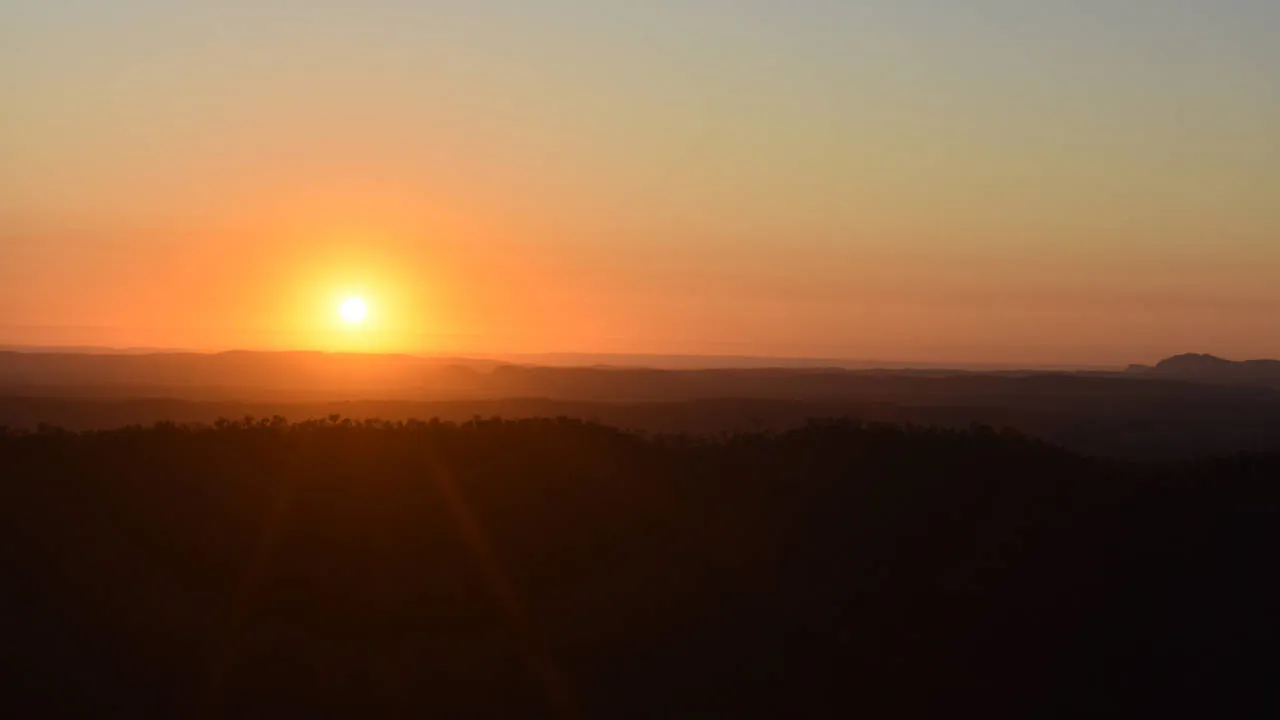
Sunrise from Boolimba Bluff in Carnarvon Gorge
Walking Distances
From main trail
2.4km
Return main trail
5.0km
Main trail to turnoff
1.2km
Full trail return
7.5km
Boolimba Bluff is the first trail off the main gorge trail, around 2.4 kilometres from the start. The views are great at any time of the day, however, we chose to view the sunrise from the top of the bluff. Towards the end of September, this meant starting the walk on the main trail at 4.15am.
The walk becomes steeper as soon as you turn off. The sunrise walk means the walk up is in the dark, so you don’t really see what you are walking through. You will notice the steps starting to get bigger and the trail narrower in places. For the most part, it isn’t too difficult until you get to the ladder.
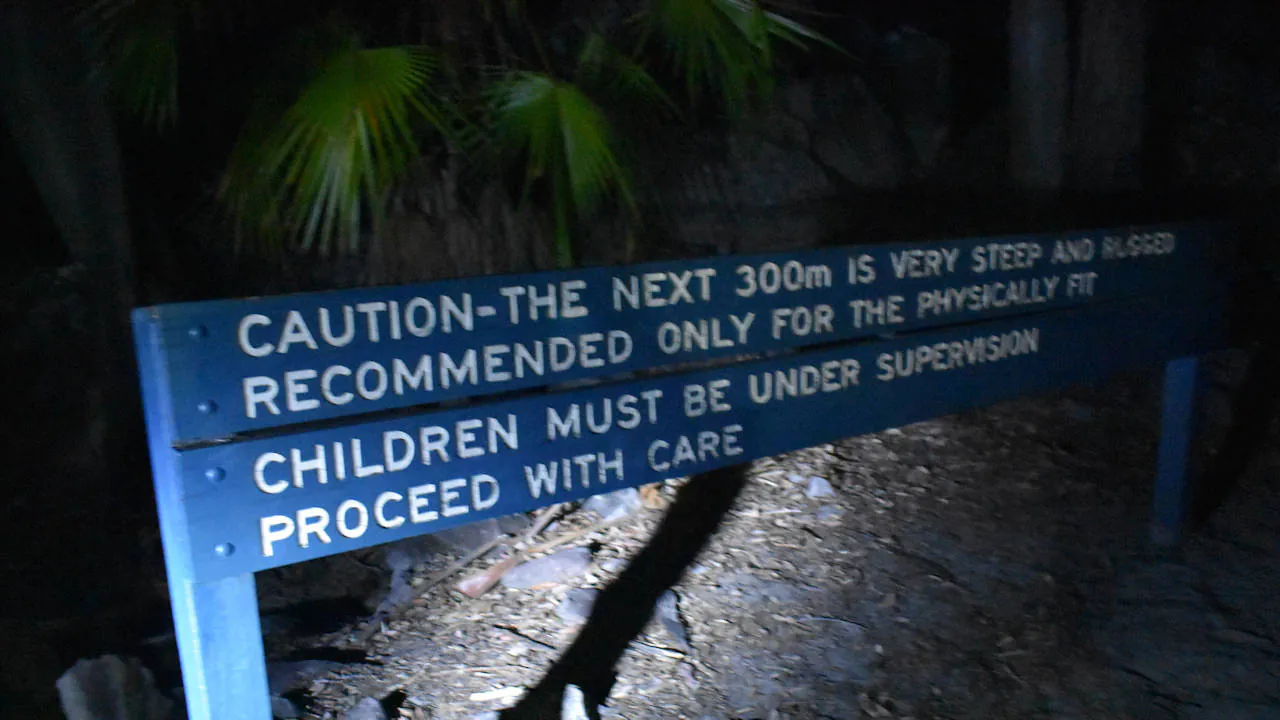
The ladder signifies where the trail becomes much steeper. Using All Trails app, the grade ranged from 2% to 15% before the ladder, then from 16% to 40% for the next 300 metres. It isn’t all from ladders either, with lots of large stone blocks for steps up the narrow gorge to reach the bluff.
Slow and steady found our way to the top of the steep section where it started to flatten out. A little bit of panic set in as we could see the glow of light through the trees but we made it to the eastern lookout with plenty of time for the sunrise, at 5.27am.
It gave us time to settle from the climb and take photos of the skyline with the pending sunrise creating beautiful warm colours out on the horizon. There was no need to panic as it was over 20 minutes before the sunrise cracked rays of light at 5.50am. We continued to watch the sunrise for the next 13 minutes as the southern walls of Carnarvon Gorge lit up in the sunlight. The main photo above was at 5.57am.
After the main sunrise event had completed, we walked to the first lookout which we passed on the way. They are only 100 metres from each other but look in different directions. The first lookout looks into the gorge with the walls of the gorge on the other side lit up by the sunlight.
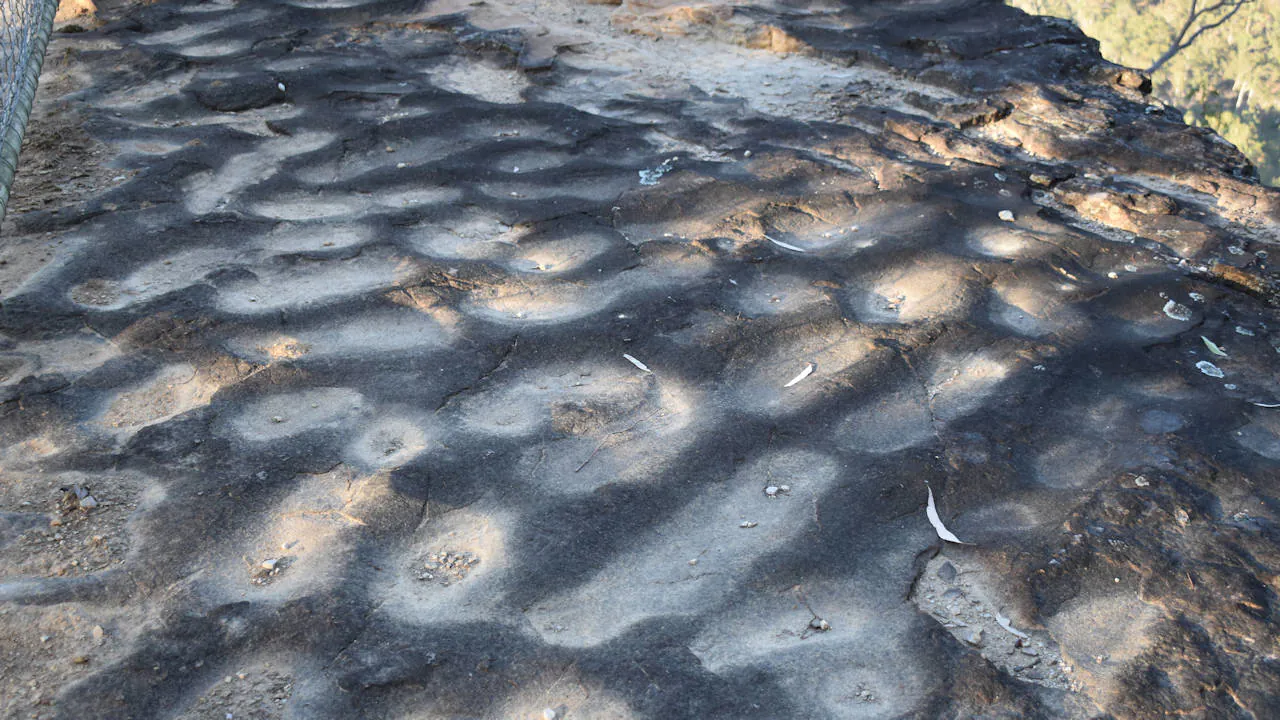
The lookout sits on a large flat rock base with a wavy scalloped shape. The shapes are puddle hollows, formed by slow-flowing water over sand some 180 million years ago after the soft sand turned into sandstone.
The walk back was a completely different experience. We began the decent down the steep and narrow gorge, seeing the ruggedness for the first time. The steps appeared larger and more treacherous than they did coming up. They are narrow and long drops off them if you stumble.
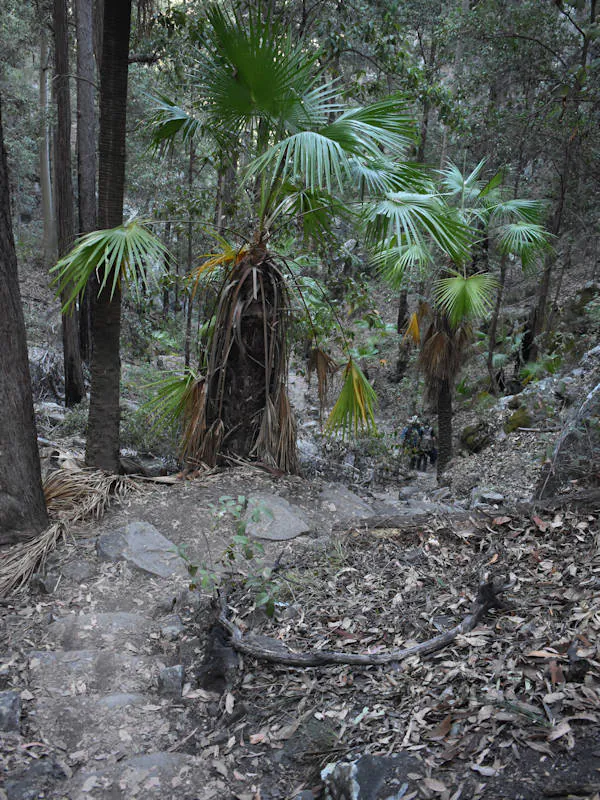
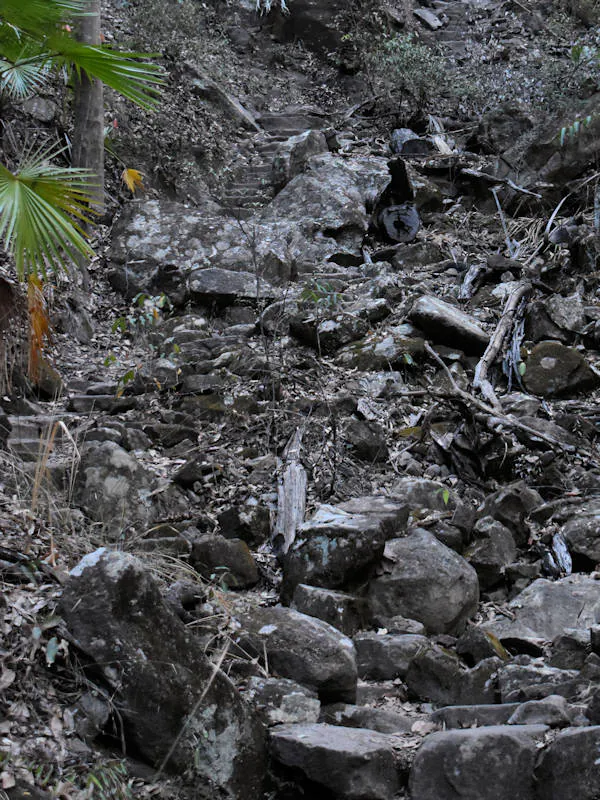
It felt like we had experienced what it must have been for Frodo and Samwise climbing the stairs to into Mordor. Even the ladders seemed to be steeper climbing down them in daylight compared to earlier in the dark.
As we reached near the bottom of the steep gorge section of the tail, almost out of nowhere, a large white cave appeared. We had no idea we had walked by it on the way up earlier.
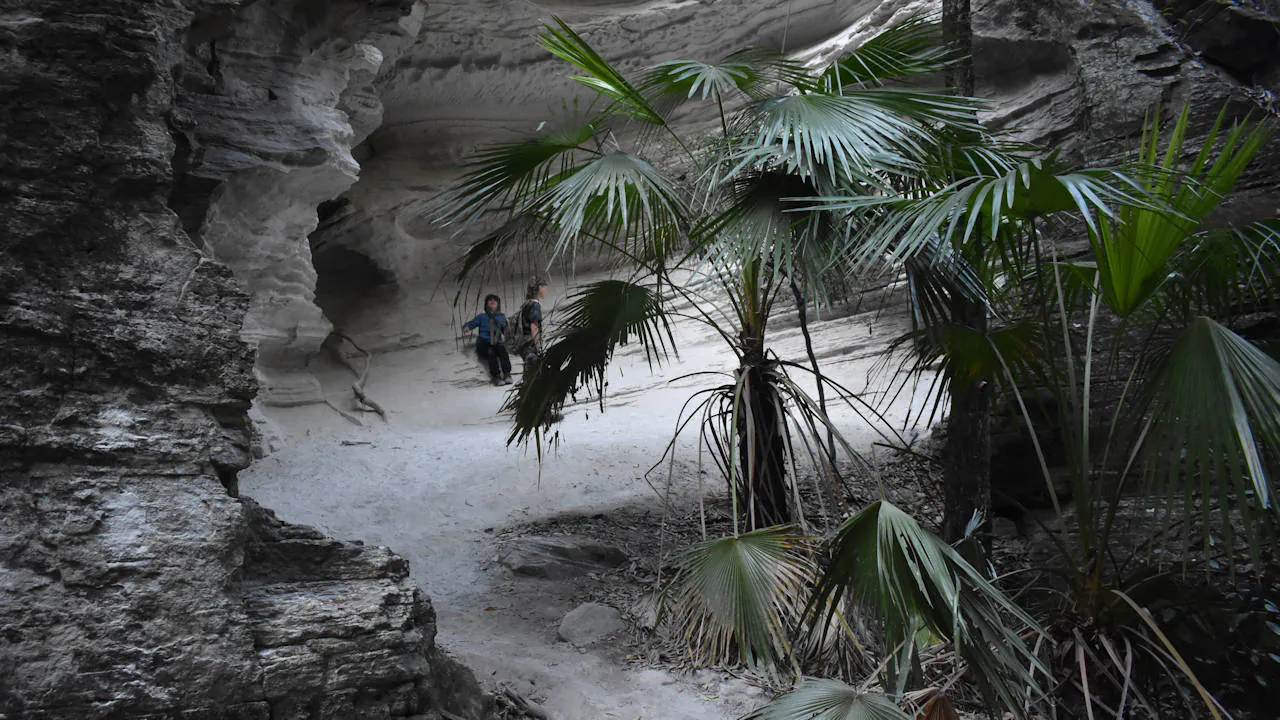
Once we descended the final ladder, the remaining walk was simply one step in front of the other. The early rise tired us for the day but the cost was minor and worth the reward. The night walk is a very different experience to walking during the day. Headlamps are highly recommended as they are easier to use while using steep ladders and rugged rock steps.
Moss Garden
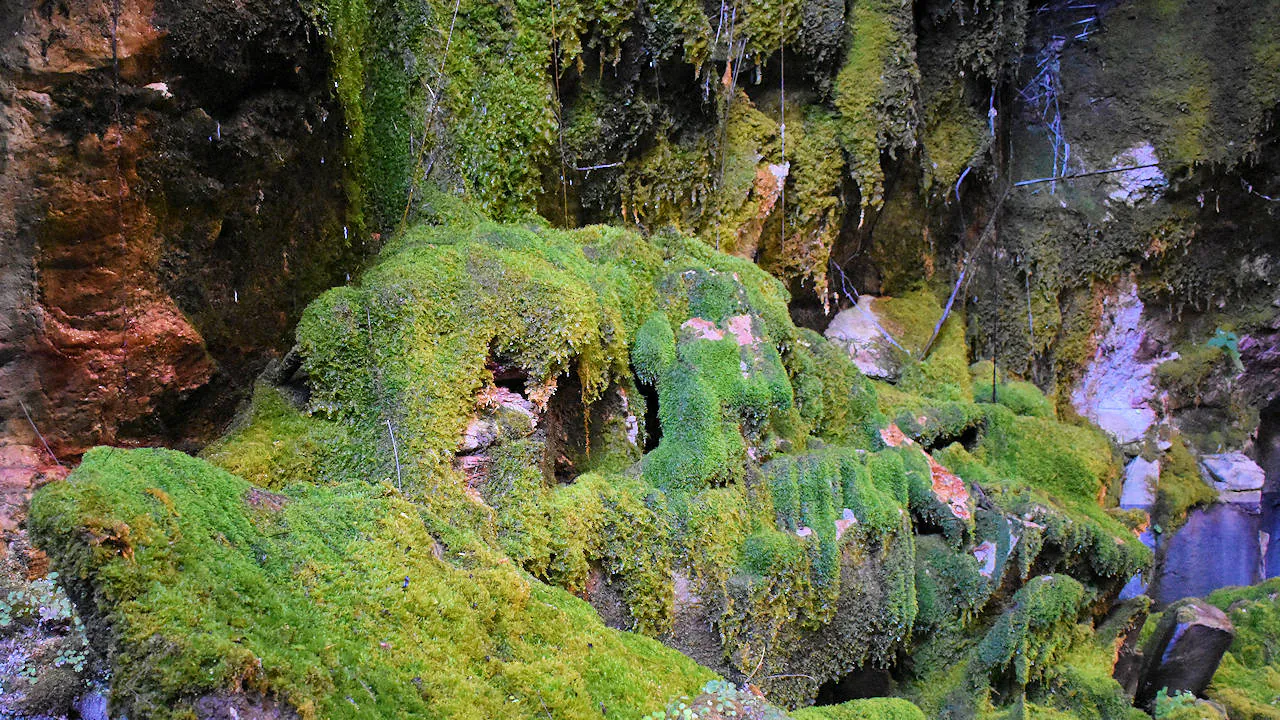
Moss grows easily with a constant water supply and protection from direct sunlight
Walking Distances
From main trail
1.3km
Return main trail
2.6km
Main trail to turnoff
2.8km
Full trail return
5.6km
The name gives you a fair idea of what Moss Garden is going to be. Branching off the main trail we head away from Carnarvon Creek, not before the second crossing over the creek using stepping stones, only this crossing is like two crossings in one with two parts.
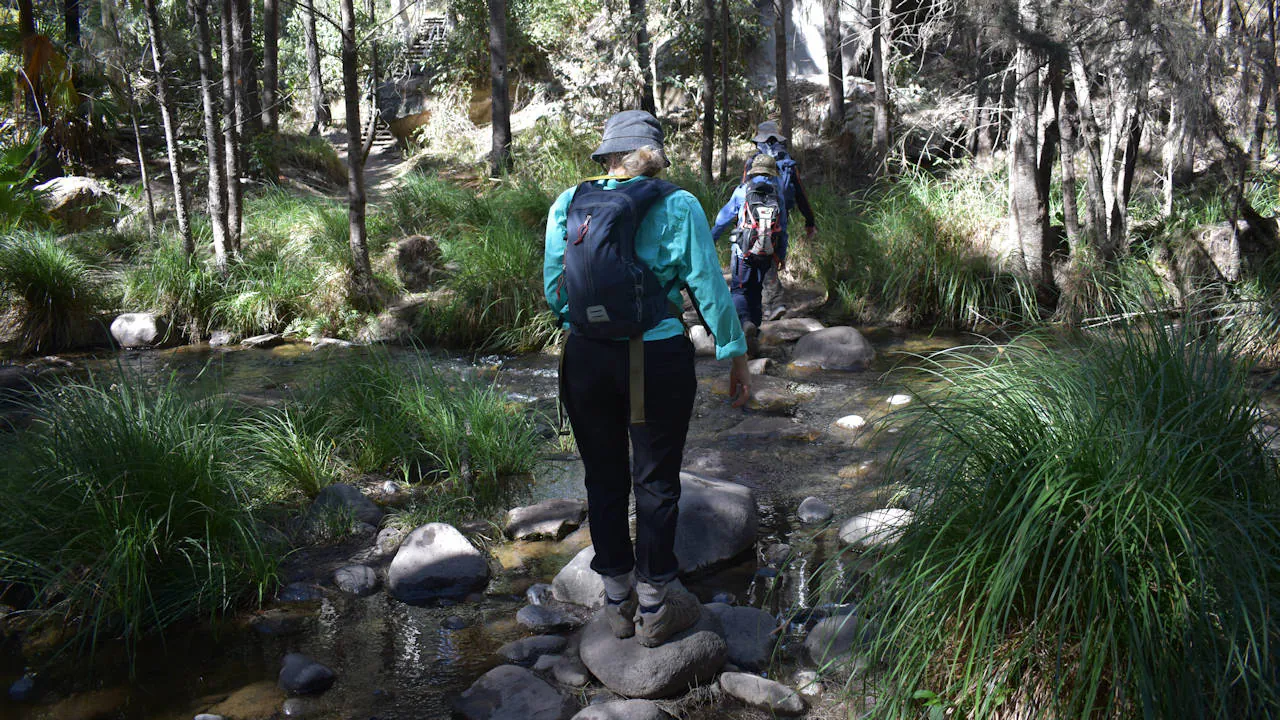
A ladder then takes you up (as many of the side trails do) away from the creek with the vegetation becoming drier with a more traditional Australian eucalypt forest. It then follows along a smaller creek, with the trail up above the water level. The trail is easy enough, however, it is narrower than the main trail with a drop down to the creek. We passed an interesting tree with large growths on the trunk.
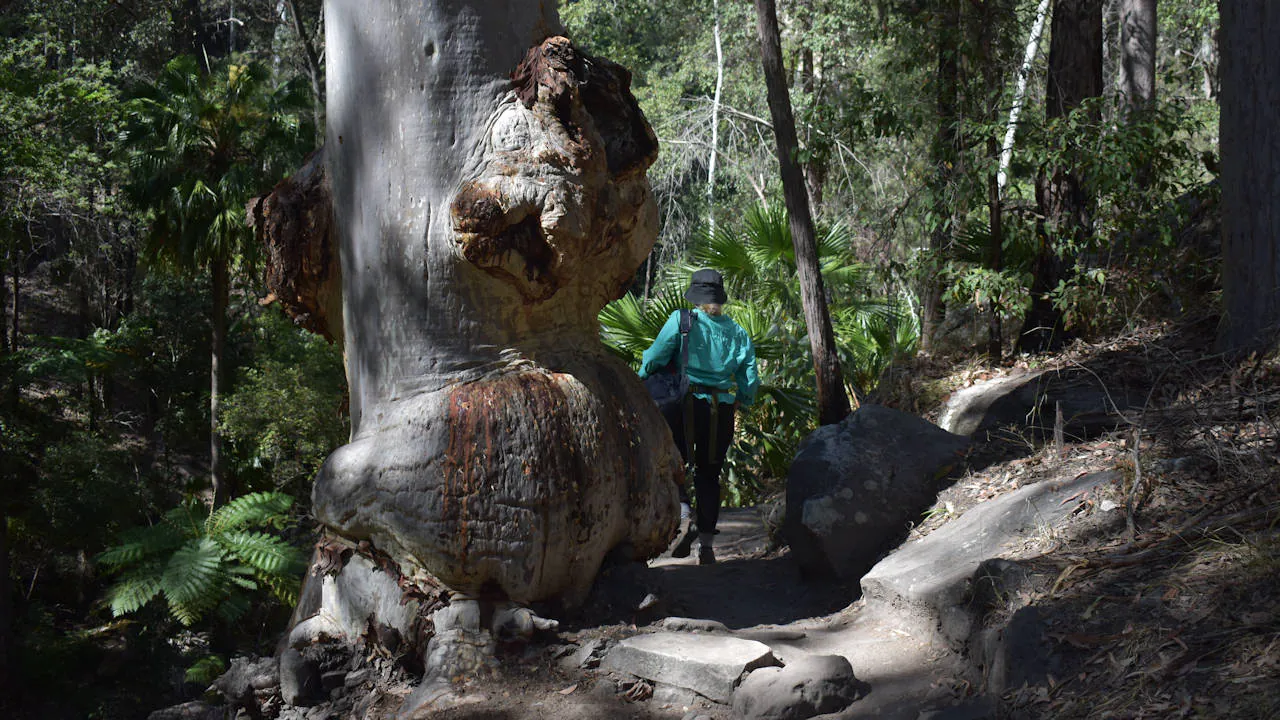
As we follow the trail upstream of the creek, the creek rises and the trail lowers to meet for another but easier stepping stone crossing. This isn’t the end of the trail but it is a nice and picturesque spot with a waterhole that looks quite inviting. I want to stick my head into the clear water and take a few gulps. I didn’t of course, and you are not allowed to swim either.
From the creek, we climbed upwards again with the help of stairs around blocks of rock. I know the stairs have been put in place to make it easier to get to Moss Garden but they feel like they are an ancient stairway to some mystical location. It isn’t far from what it is. More stairs and a bit more walking and the Moss Garden is seen ahead.
The Moss Garden name is apt for the beautiful natural display shown in the side-gorge, tucked around the corner and predominately protected from direct sunlight. The rock wall is damp and constantly dripping with water. The ledges, large and small, are covered in moss and small ferns, lapping up the endless supply of moisture in the permanently shaded space.
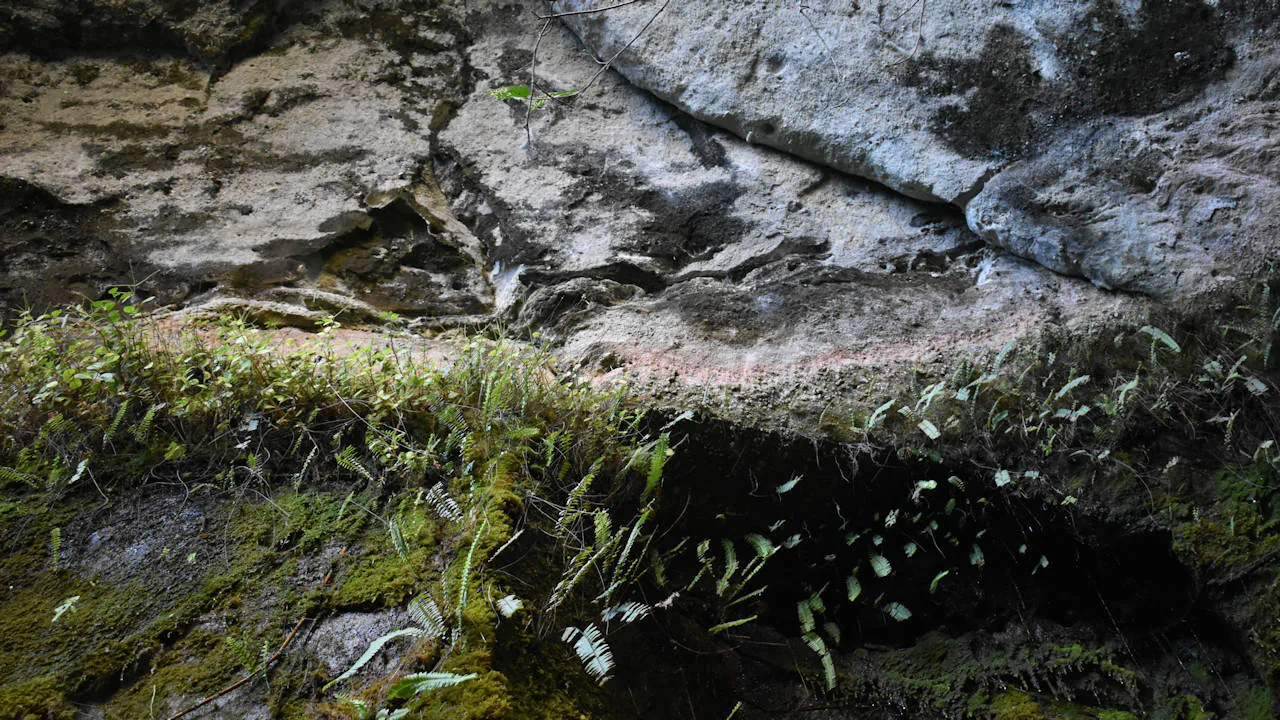
The sandstone cliffs absorb water that may have fallen as rain hundreds or even thousands of years ago. The water hits a shale base and runs out the side of the sandstone cliff walls. Because the process is so slow, a drought that last for many years will still see a constant flow of water escaping the sandstone. Plants that couldn’t normally survive in an environment where Carnarvon Gorge is located, instead, thrive in an oasis of mosses, ferns, and liverworts.
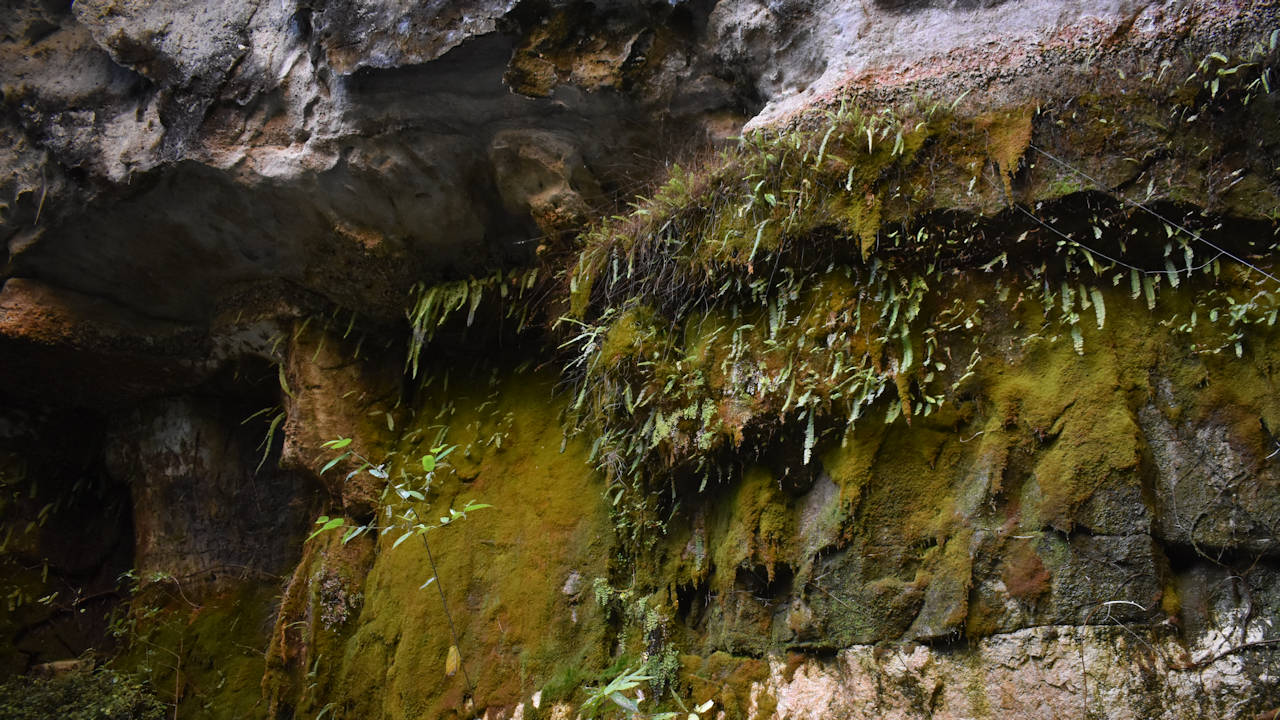
You can see the clear line where the harder rock base sits. Basically, it is where the greenery begins. The moist and cool air was also refreshing and relaxing. We stayed for quite a while as others came and went while we were there. With only two locations we intended to visit this day, we had time to take it in before heading to the Amphitheatre.
Amphitheatre
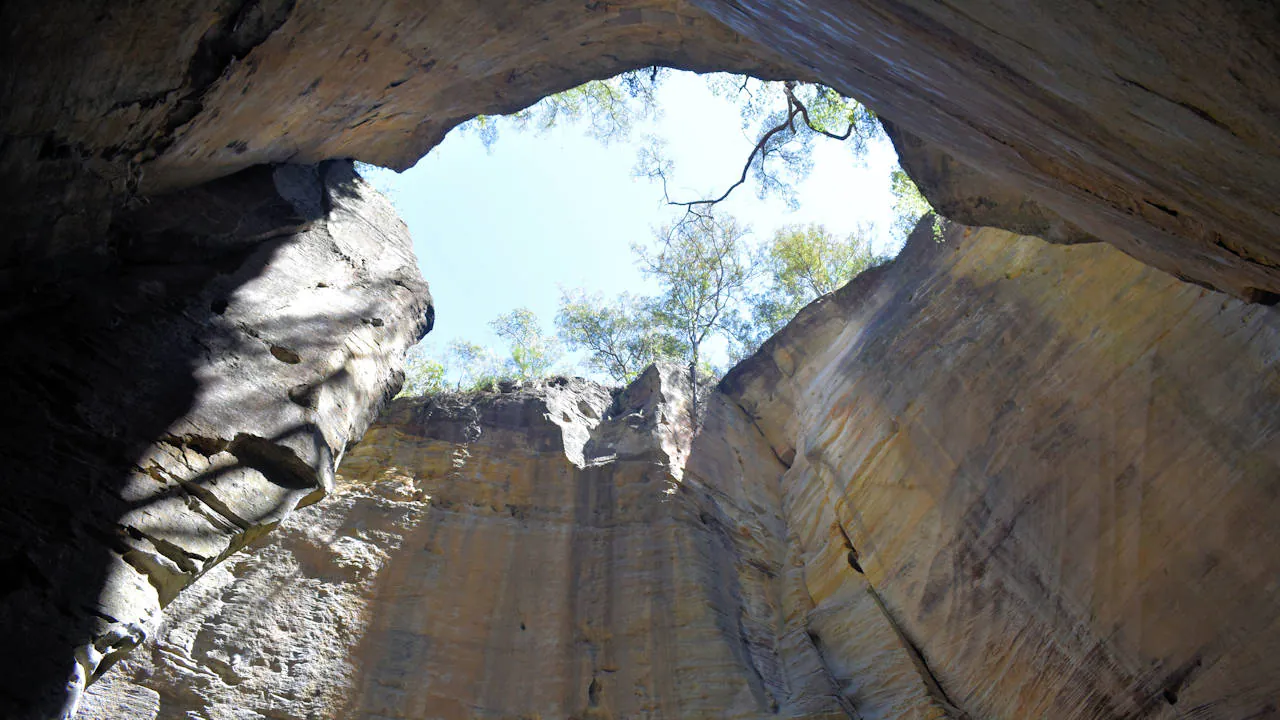
Looking upwards from within the Amphitheatre
Walking Distances
From main trail
1.3km
Return main trail
2.6km
Main trail to turnoff
3.7km
Full trail return
7.4km
The turnoff to the Amphitheatre is a few kilometres along the main trail, located after the 3rd creek crossing. Another creek crossing off the main trail starts the kilometre or so to get to the entrance of the Amphitheatre. The trail isn’t too difficult with stone stairs for most of the climbing parts of the trail.
It eventually brings you first to the base of the rock walls of the gorge. Here, there are some seating where a few people leave their packs behind before climbing the triple set of stairs to climb up to a narrow crevice. In fact, they are not stairs, they are ladders. Similar to the ladders to Boolimba Bluff, except the three ladders are together with small platforms between them. They seem okay looking at the photos afterwards, however, fear of heights had a couple of us hanging on tightly.

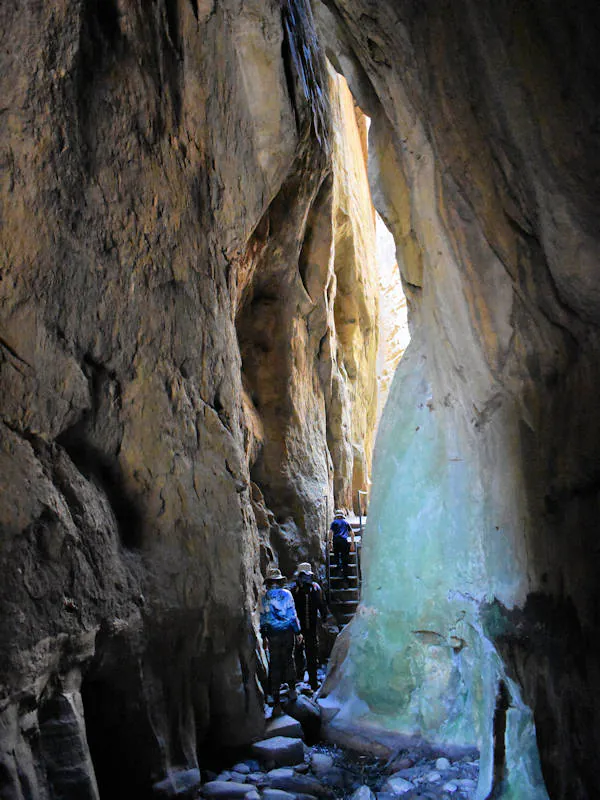
Once the ladders have been conquered, the walk through the crevice is easy. There are some steppingstones that suggest there could be water flowing through when it is wet, but it was mostly cool and damp, hidden from any direct sunlight. At the end of the crevice is a smaller and final ladder and it immediately stuns, clearly making sense of why it gets its name.

The rock crevice opens out to a large open area, apparently surrounded by tall sandstone cliffs on all sides, even though it does continue further on. To the left is a viewing area, backed be a natural space that looks like it was deliberately carved out as a seating place for an amphitheatre stage. Instead of seats, there are rock benches and hillside that goes upwards towards the back so you can see over the patrons in front.
We were lucky enough to have a few moments with no other person there. The enclosed space means sounds are easily amplified and the quiet in the absence of other people, you can hear the insects and occasional birds flying through.
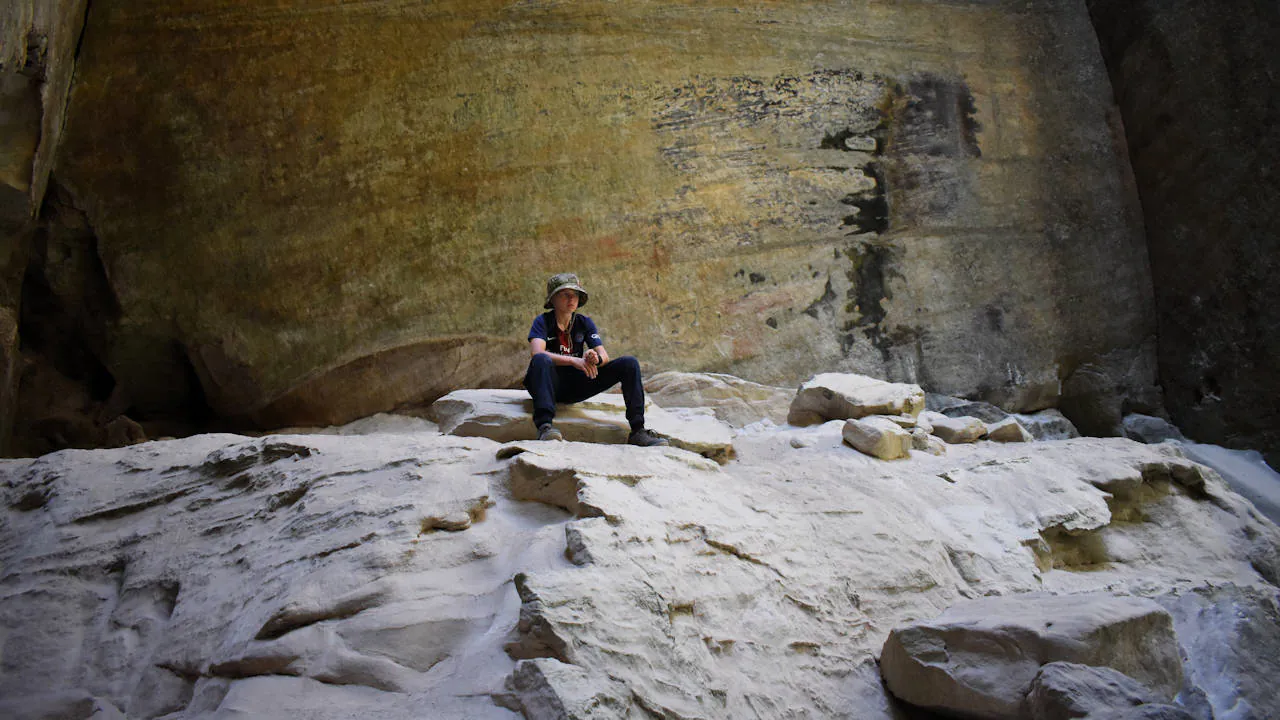
Carnarvon Gorge felt like it could be host to numerous movie sets. If climbing the rock staircase to Boolimba Bluff felt like climbing the rock stairs into Mordor, the Amphitheatre felt like we had entered a sietch on the planet Arrakis in Dune. Like a sietch, the Amphitheatre is cool relief from an otherwise hot environment on the outside.
Wards Canyon
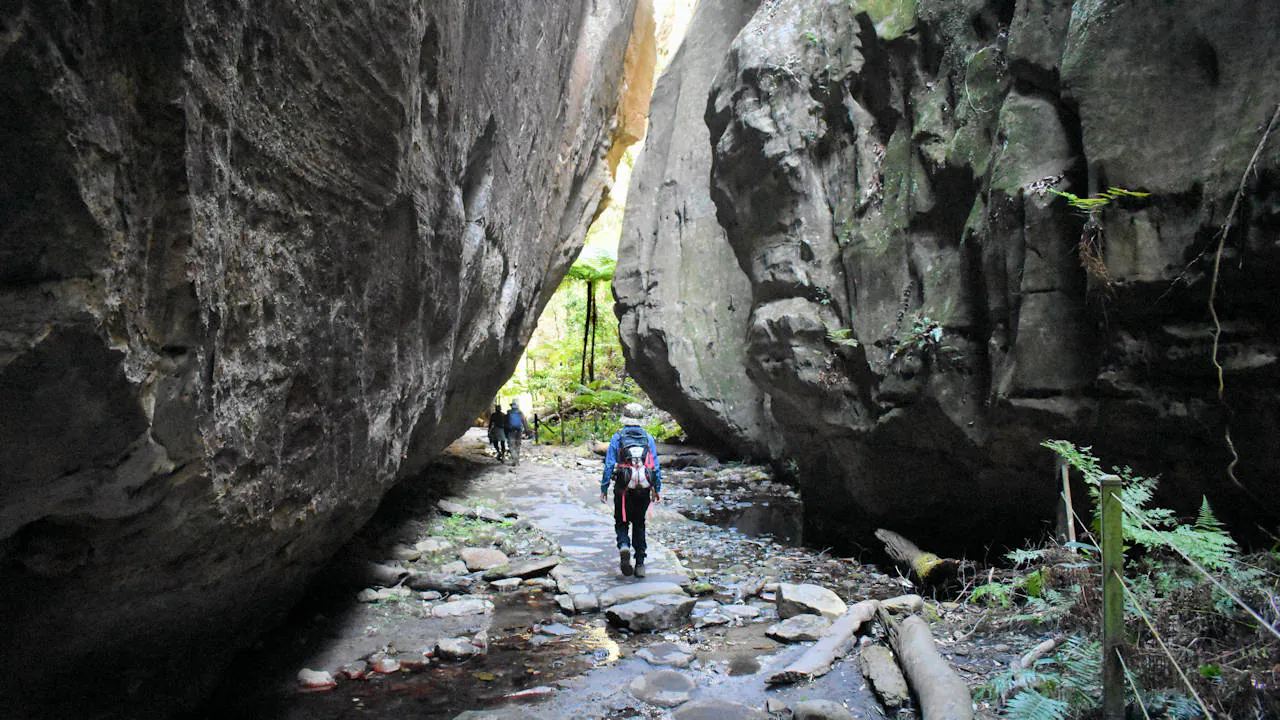
Walking through Wards Canyon
Walking Distances
From main trail
0.6km
Return main trail
1.2km
Main trail to turnoff
5.1km
Full trail return
10.2km
On our way to Carnarvon Gorge, meeting others that have already been, Ward’s Canyon was commonly mentioned as a highlight and favourite feature. We had already worked out our walking plan and Ward’s Canyon was the first feature we decided to stop at on our way to Big Bend. The trail off the main trail is fairly short but quickly takes you upwards with the help of some stairs.
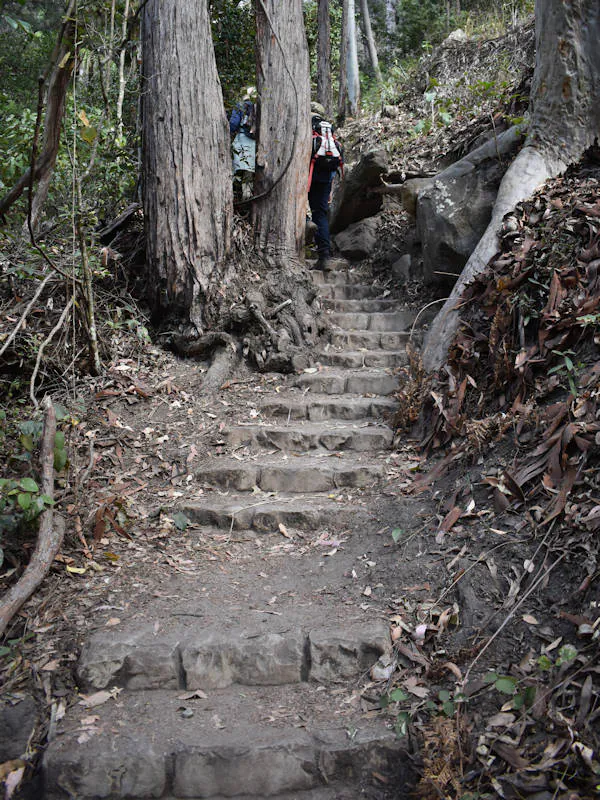
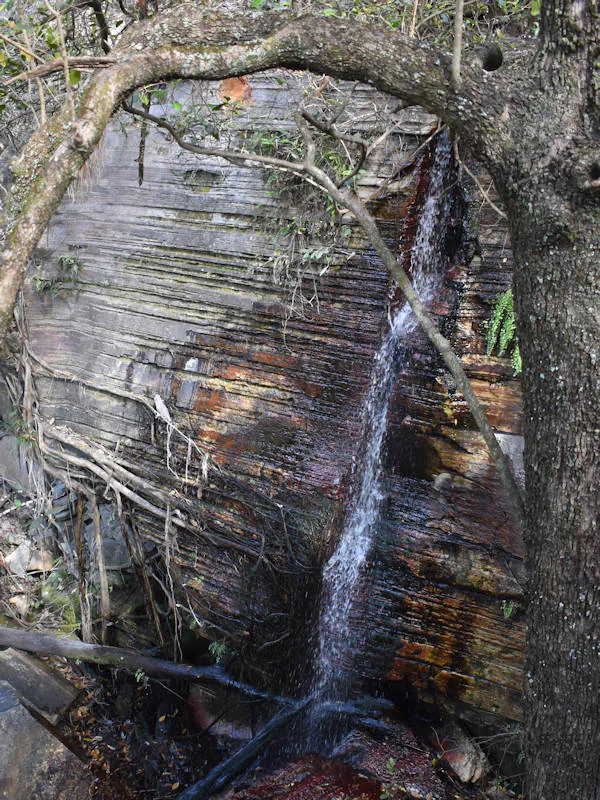
A small waterfall with a viewing platform above it is part way up to the canyon, a great excuse for a quick break. The better spot for the waterfall to be seen from a rock staircase before reaching the platform.
Coming into Ward’s Canyon, there is a small creek flowing out to the waterfall. The creek flows through the length of the canyon with the trail following either the left or the right side as you progress further in. It starts of semi-open with green ferns and tall palms.
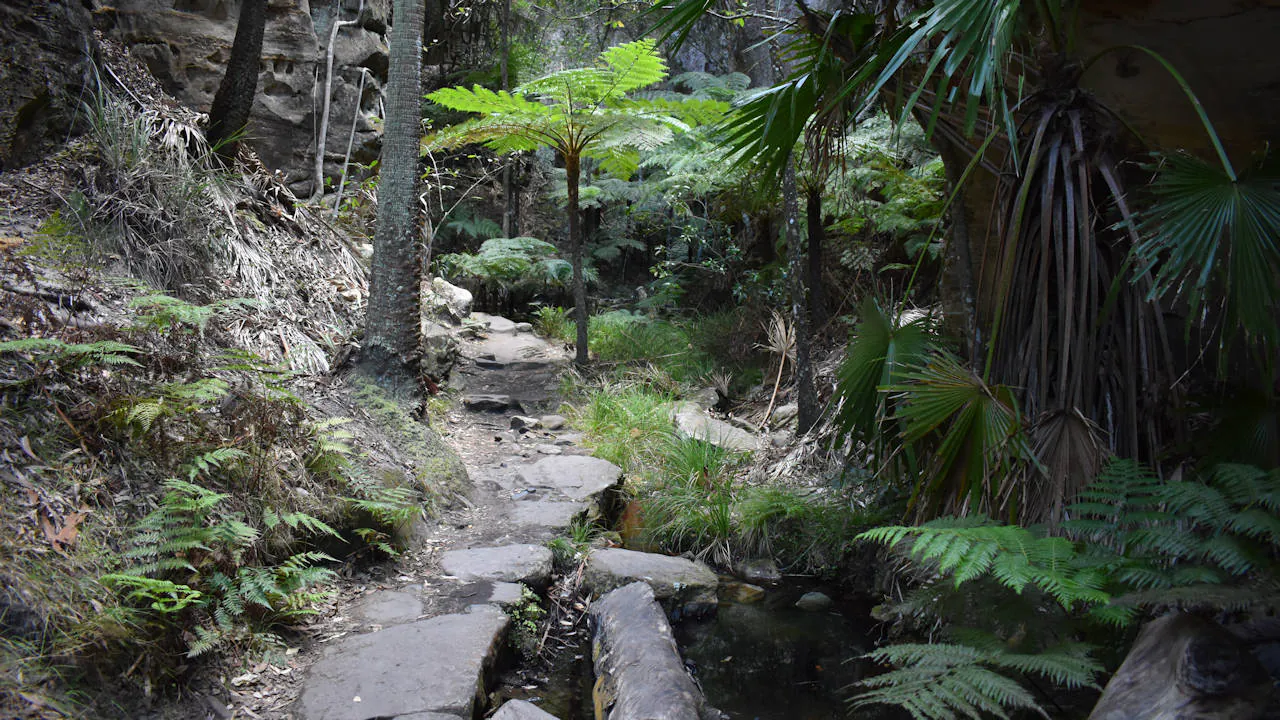
The canyon closes in with one side partially under the walls of the canyon and a rock platform that holds only dust without any vegetation. By the time you head into the end of the trail, the canyon’s features change again.
The constant water flow and protection from sunlight gives Ward’s Canyon a damp feeling. Sit on the stone edges and you’ll end up with a damp bottom, but the general feel is quite humid. Luckily, the temperature is quite low, so it doesn’t feel uncomfortable.
It is here where you can see the King Ferns. The fronds of the king fern have no woody tissue. Instead, water fills the five-metre-long fronds, filling them like a fire hose to keep them rigid.
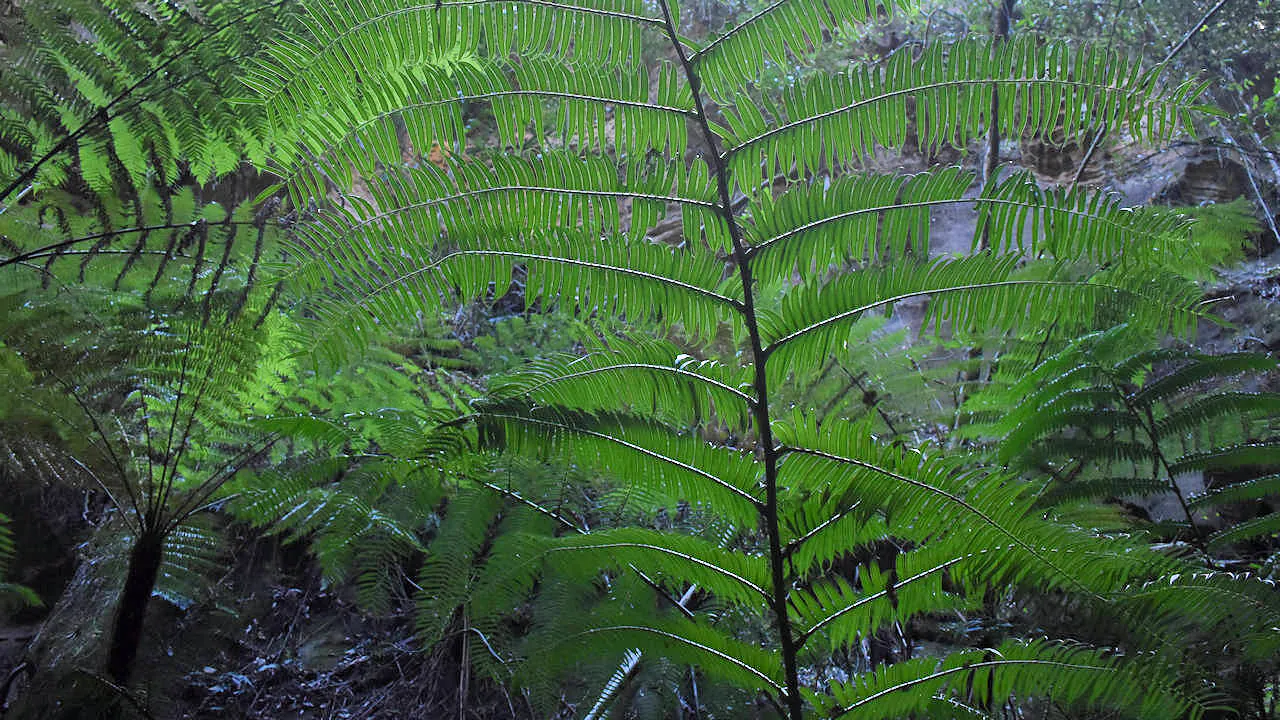
The wet and cool environment in Ward’s Canyon provides the conditions needed for the ancient King Ferns to continue to survive here. The only inland place they can be found, with other king ferns found near the coast, such as in the Daintree Rainforest, Finch Hatton Gorge in Eungella National Park, Cape York, and Fraser Island. Normally, the inland climate in Australia is too dry and hot. Carnarvon Gorge’s unique geology creates a time capsule of the rainforest environment that once dominated this area.
The canyon’s name comes from the Ward brothers, possum hunters in the early 1900s. The cool canyon was a good place to store their pelts.
Art Gallery
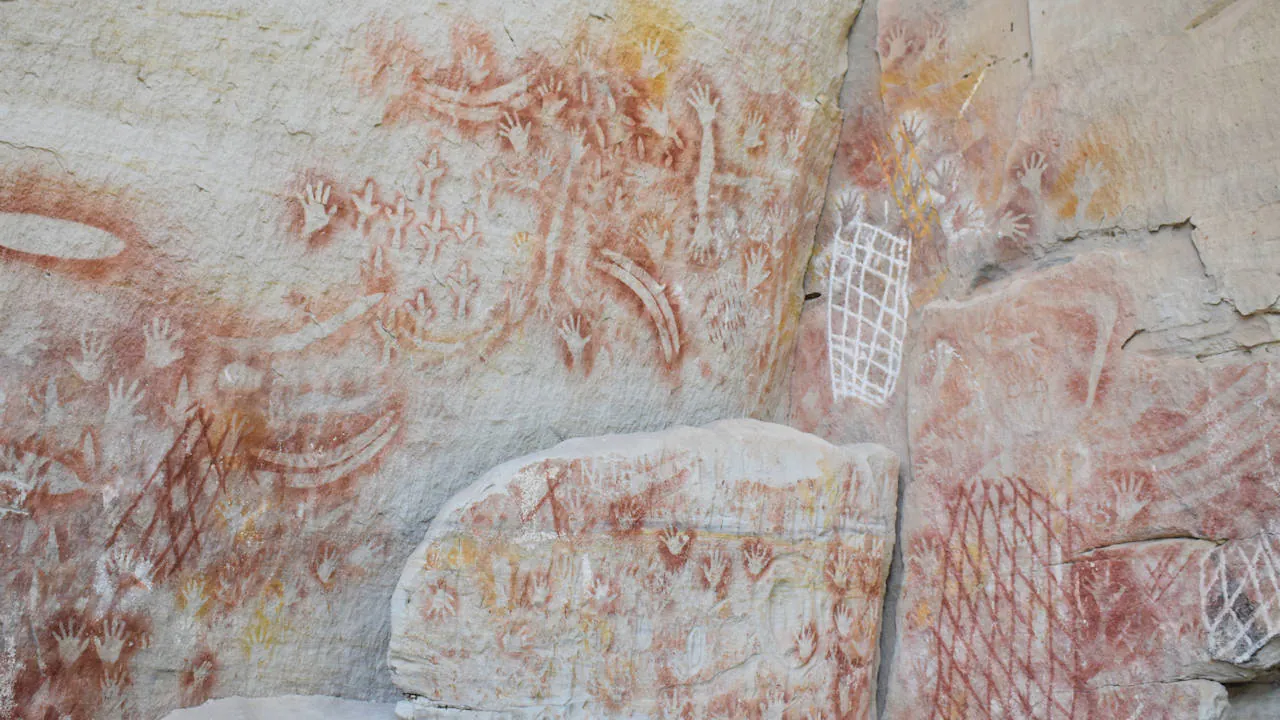
Aboriginal telling of stories through symbolic art
Walking Distances
From main trail
0.6km
Return main trail
1.2km
Main trail to turnoff
5.9km
Full trail return
11.8km
The Art Gallery is one of two Aboriginal art features along the Carnarvon Gorge walks. It was the second feature we stopped at, after seeing Ward’s Canyon, with an easier more gradual climb. The trail leads through a split boulder, with several others surrounding the trail that you would expect to see in the granite rock gardens of Girraween National Park.

The trail approaches a cliff wall were at first it appears the trail may end and a small cave area where the art presumably may be found. Getting closer to the cliff, a gap opens up revealing a sort of stairway up to the next level. A sign before it notifies you of the spiritual importance of this place to the Aboriginal people. The images having meaning and purpose, the symbols being their written language telling stories of their time in this place.
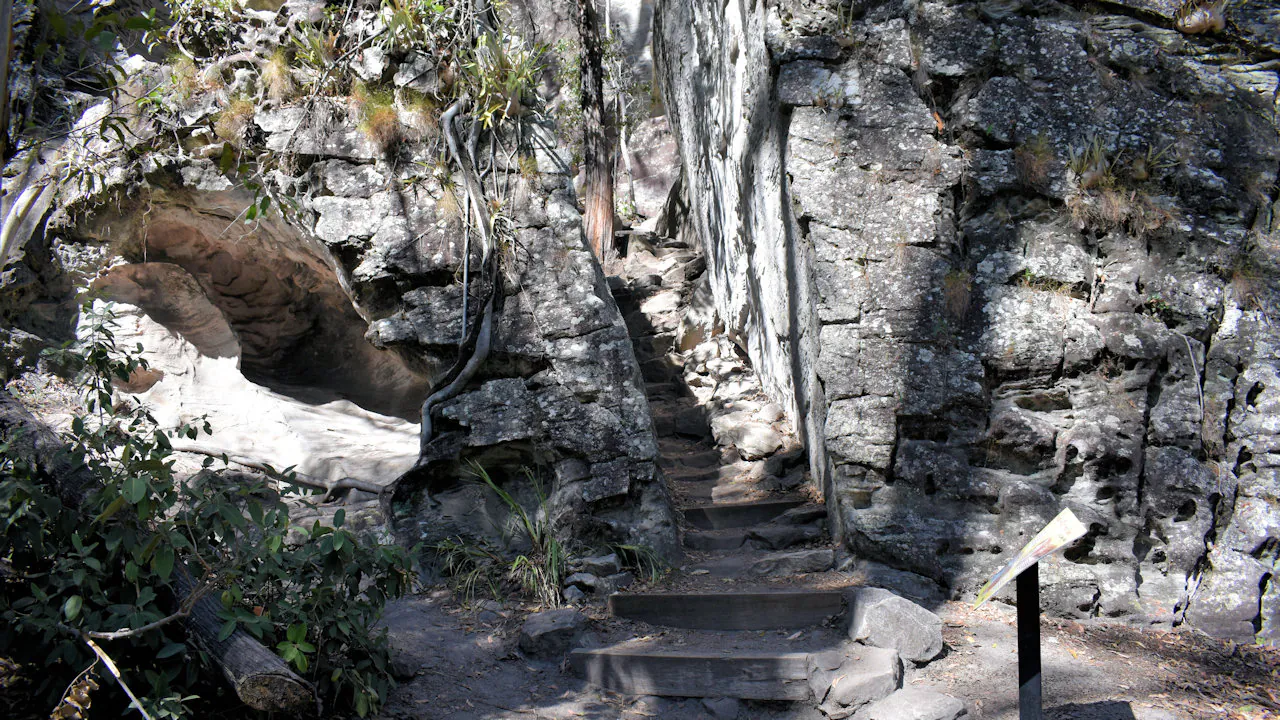
After ascending the stairway, a pseudo front gate to the Art Gallery, a boardwalk is revealed that follows along the side of the white sandstone cliffs. Red ochre symbols are seen, along with yellow ochre and white kaolin paintings, and rock carvings in the walls.
Many of the symbols are outlines created by spraying the ochre or kaolin over an object held against the wall. Hands are the most common seen, along with boomerangs and the occasional stone axe. Some of the hands extend further along the forearm. The oval shapes are from shields. The elbow 7-shaped boomerangs were used in fighting. Large, heavy and solid, they could easily cause injury to an opponent and even break legs.
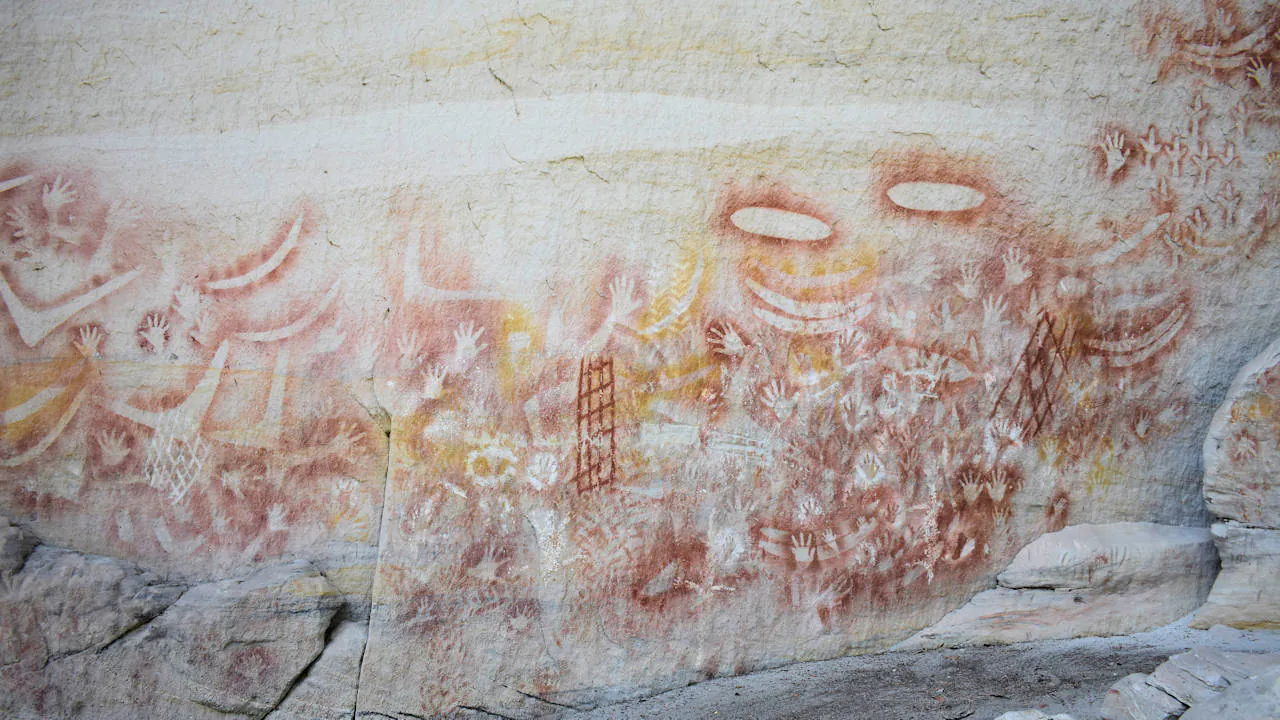
Some of the art are freehand drawn, such as the nets. While nets were made and used in hunting to block off an area, the net paintings represent something entirely different. Freehand net paintings mark locations where the burial of ancestors had been laid to rest. Sadly, the bodies of Aboriginal people were removed some time in the past.
Further along the paintings are replaced with carved drawings. The most prominent is a motif of a vulva, representing fertility. There is the occasional ochre painting in this section, however, mostly it is of “women’s business”.
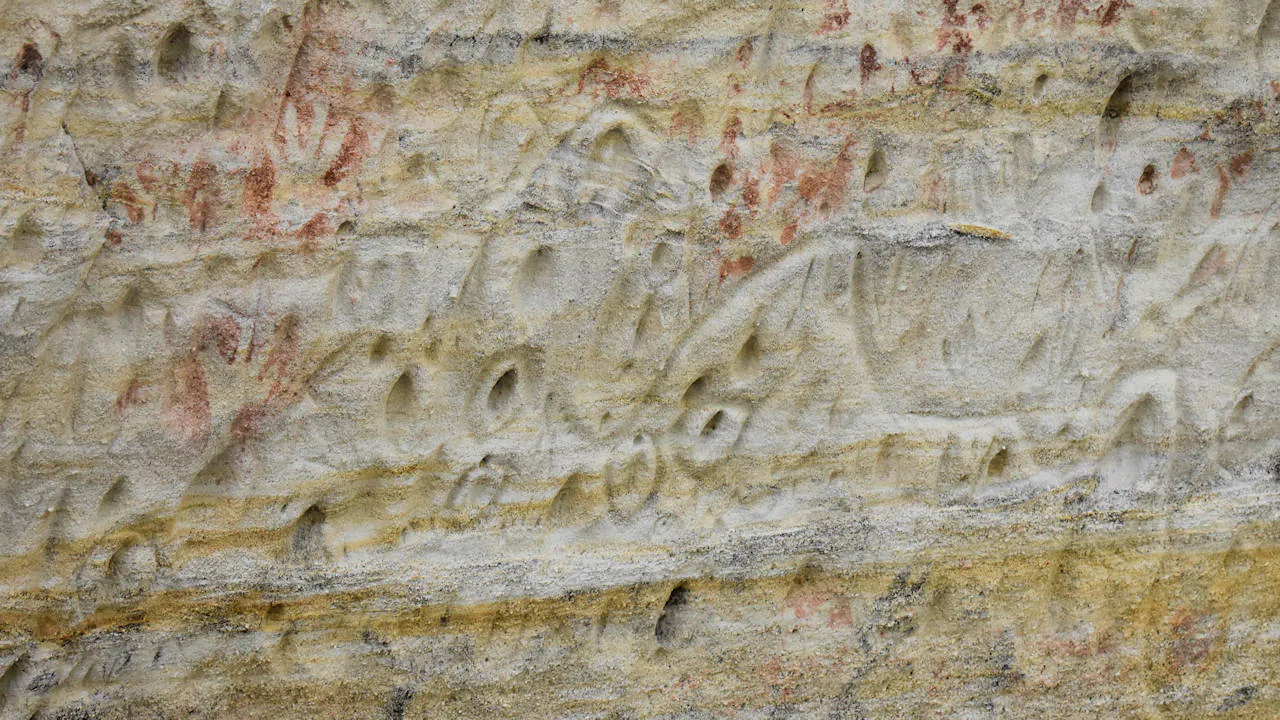
One large carving spans across a large section of the wall. Mundagurra is one of the Aboriginal people’s creation ancestors. Mundagurra lay dormant before bursting from underground, forming the cliffs and mountains and forming the rivers of the Carnarvons.
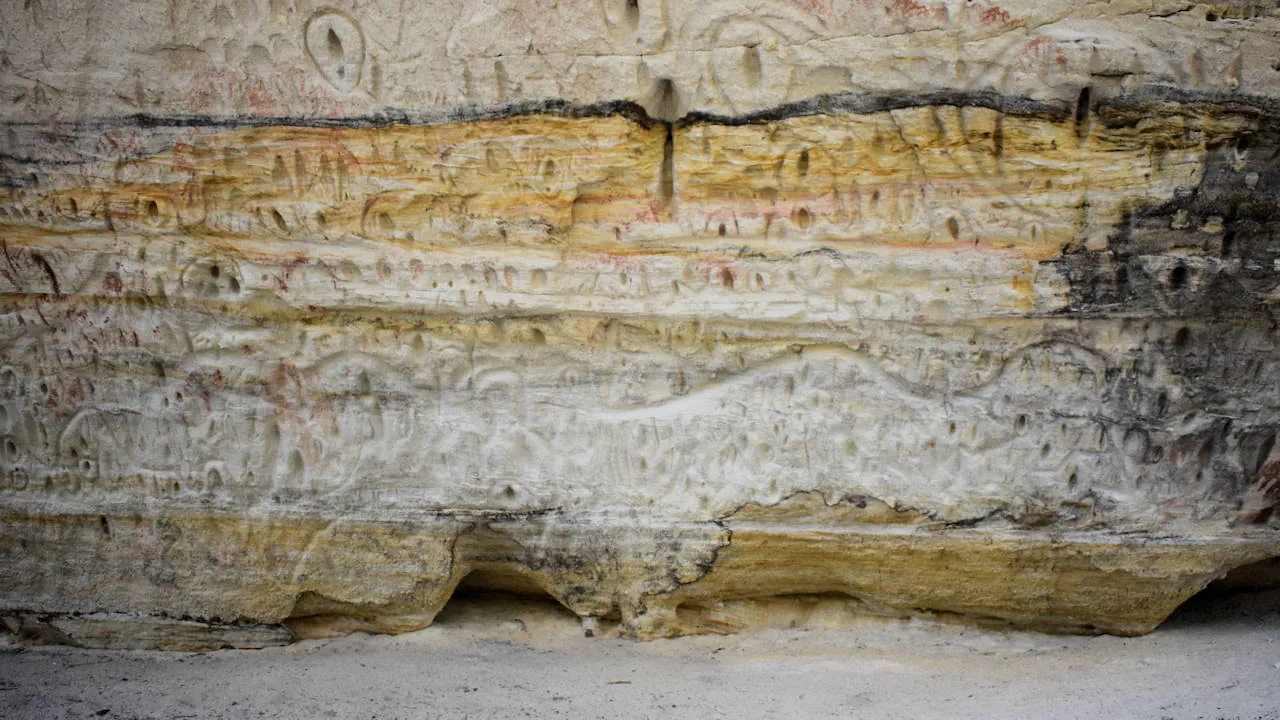
Cathedral Cave
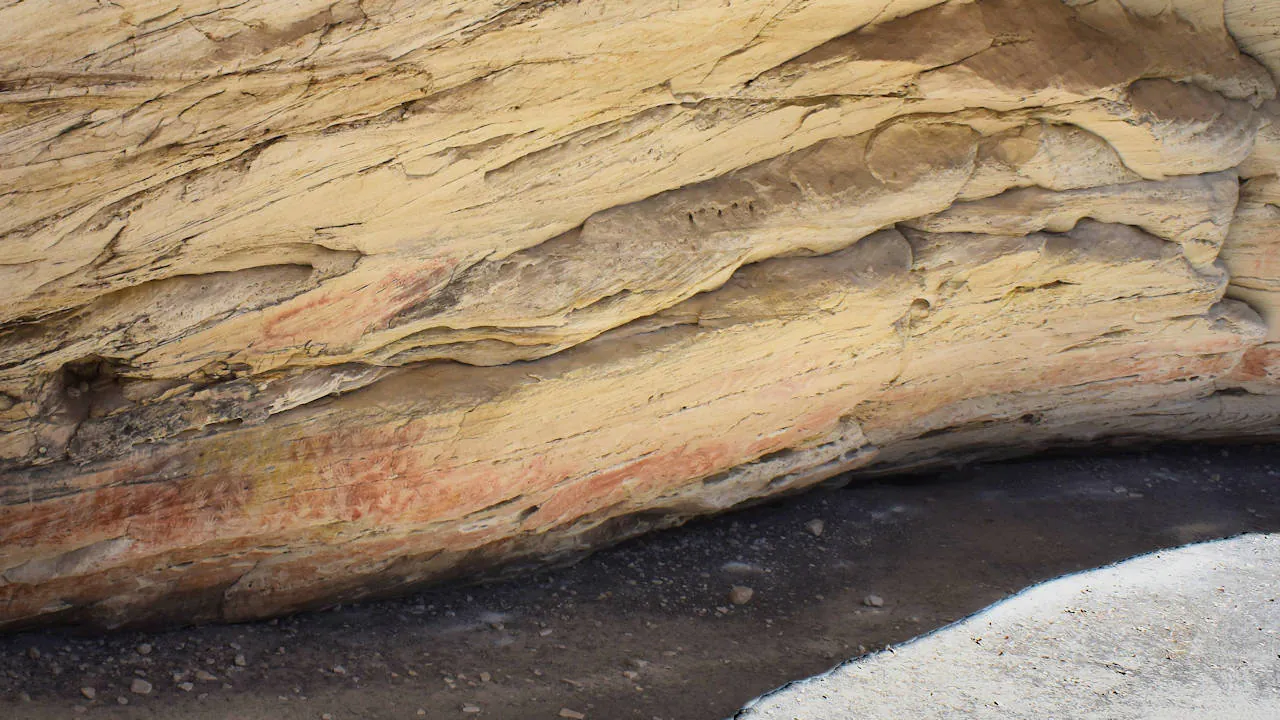
Aboriginal art at the Cathedral Cave
Walking Distances
From main trail
0.0km
Return main trail
0.0km
Main trail to turnoff
9.9km
Full trail return
19.8km
Most of the features, the named ones at least, are on side trails. Cathedral Cave is the only one that is next to the main trail of Carnarvon Gorge. At a glace, the Cathedral Cave appears to be similar to the Art Gallery. Some of the symbols are similar, some others are unique including one that I missed when there.
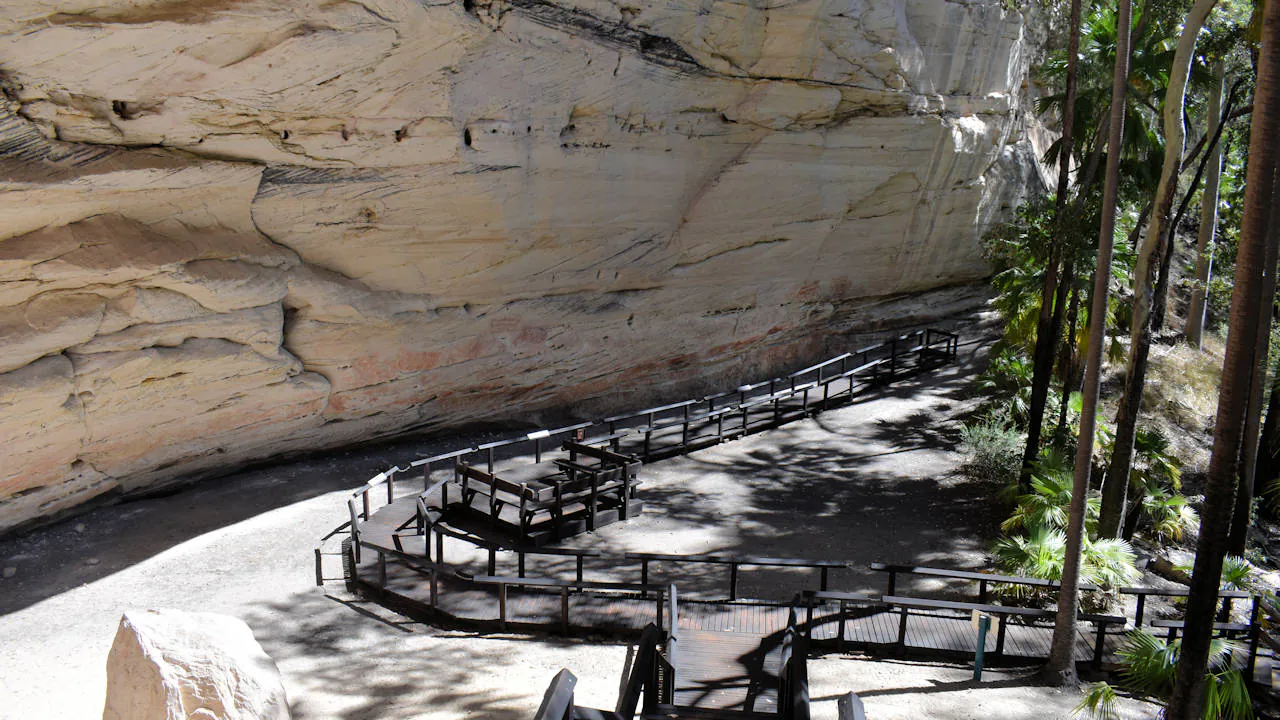
The Cathedral has a wooden boardwalk along the length to view the Aboriginal artwork from. Most of it is along the base of the rock wall. To the left is elevated with stairs leading up to the platform, giving an amazing perspective of the entire Cathedral Cave, and closer to the higher paintings near the upper platform.
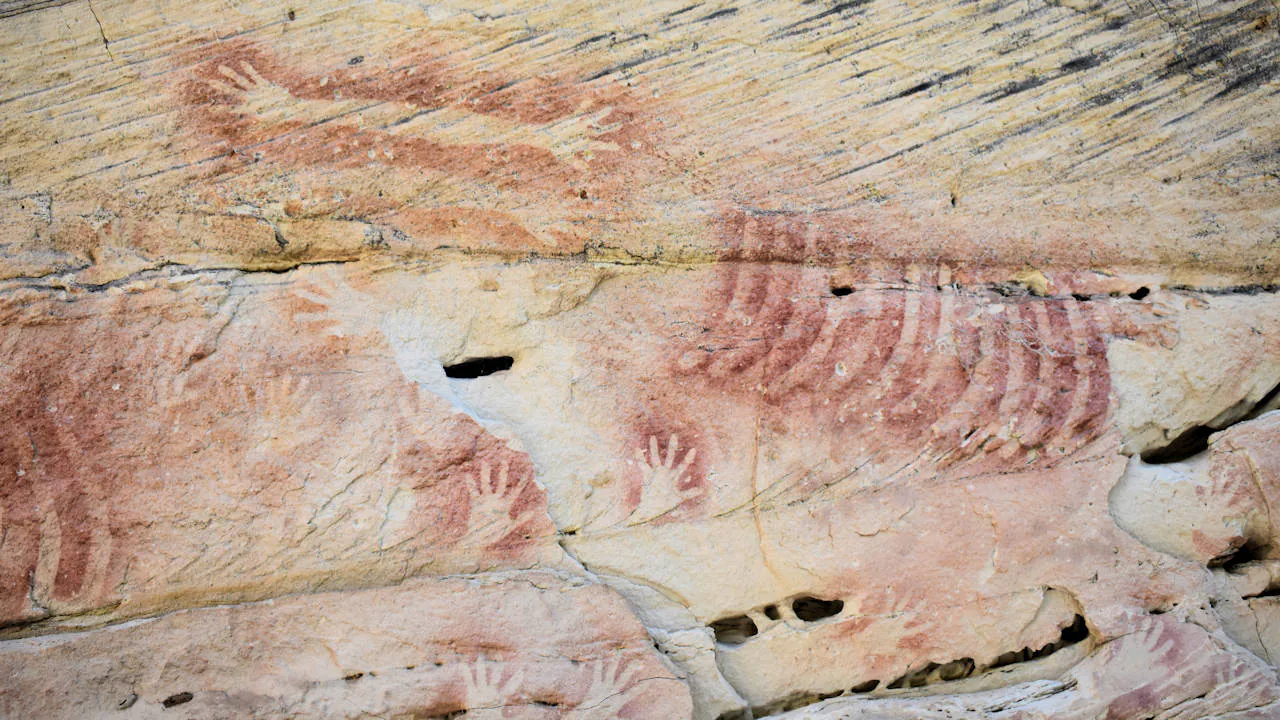
Boowinda Gorge
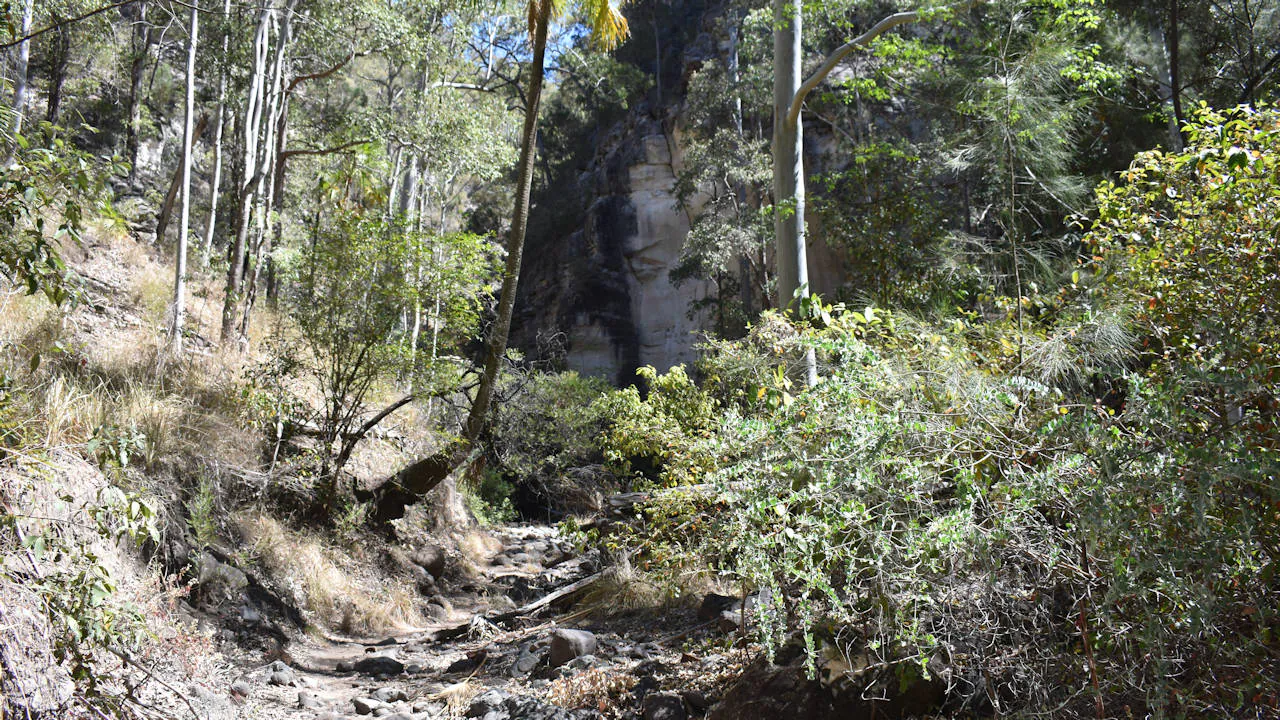
Entrance to the Boowinda Gorge trail
Walking Distances
From main trail
0.5km
Return main trail
1.0km
Main trail to turnoff
10.0km
Full trail return
21.0km
Boowinda Gorge is the one spot we regret not actually going to. The photo shown is the entry to the gorge and is as much as we saw of it. Being close to Big Bend, Boowinda Gorge is a long walk to get to when you are returning for the day. An overnight camp at Big Bend would change this entirely. Having said that, adding Ward’s Canyon to our second longest walk day would have given us the extra time for a quick explore.
The walk along Boowinda Gorge is over boulder rocks, so it is a slower walk than the other trails. Most we spoke to said 20 minutes in gives you the main experience with little more continuing further. One told us they walked three hours return without reaching the end, a reflection of the slow going rather than the length of the gorge.
Another advantage of camping at Big Bend is you get enough time to walk up to the Battleship Spur, the outcrop above Big Bend. Access to Battleship Spur is part way along Boowinda Gorge. Friends of ours left their camp at Big Bend in the morning and collected their gear after returning from the spur.
Big Bend
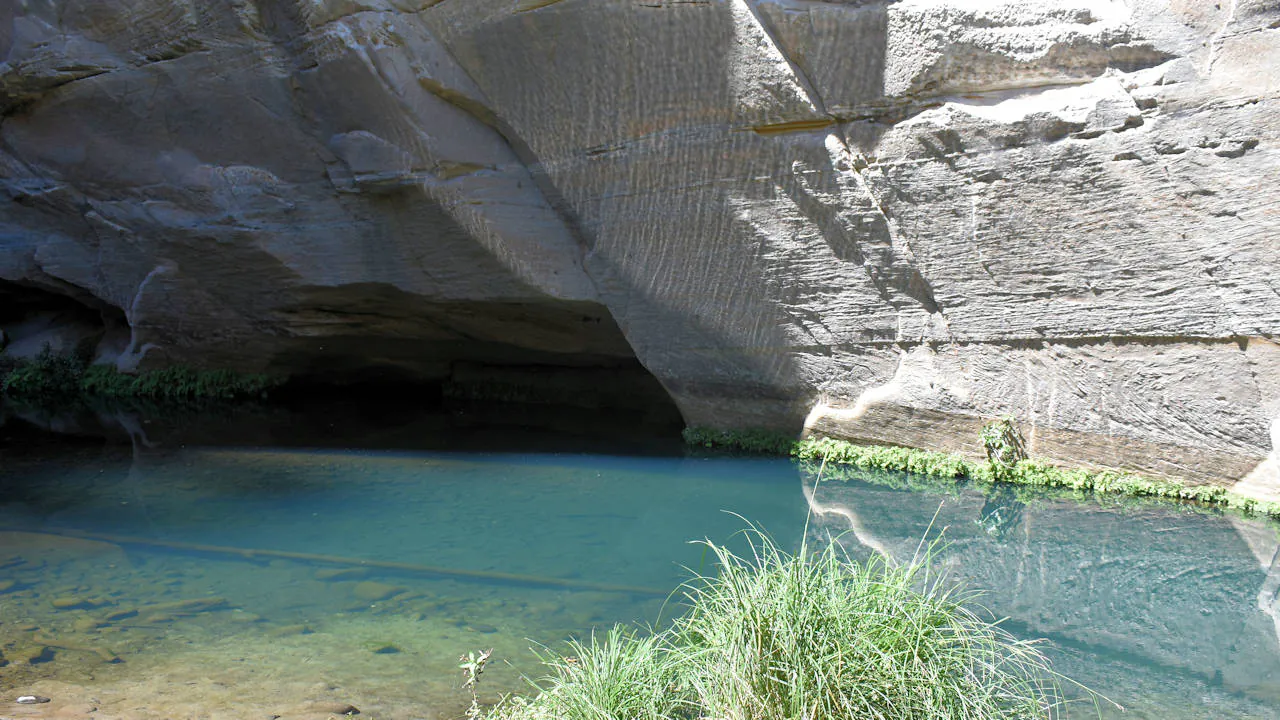
No swimming at the inviting waterhole at Big Bend
Walking Distances
From main trail
0.0km
Return main trail
0.0km
Main trail to turnoff
10.7km
Full trail return
21.4km
The main walking trail through Carnarvon Gorge brings you to the final feature, Big Bend. Swimming is not allowed in the water but on a hot day the temptation is there when presented with the beautiful and inviting water pool. Of course, we didn’t swim. Aside from the environmental impacts, swimming would likely disturb the water and sediments making the water cloudy. We saw this happen at Mossman Gorge with many people walking by not even realising what they missed out experiencing.
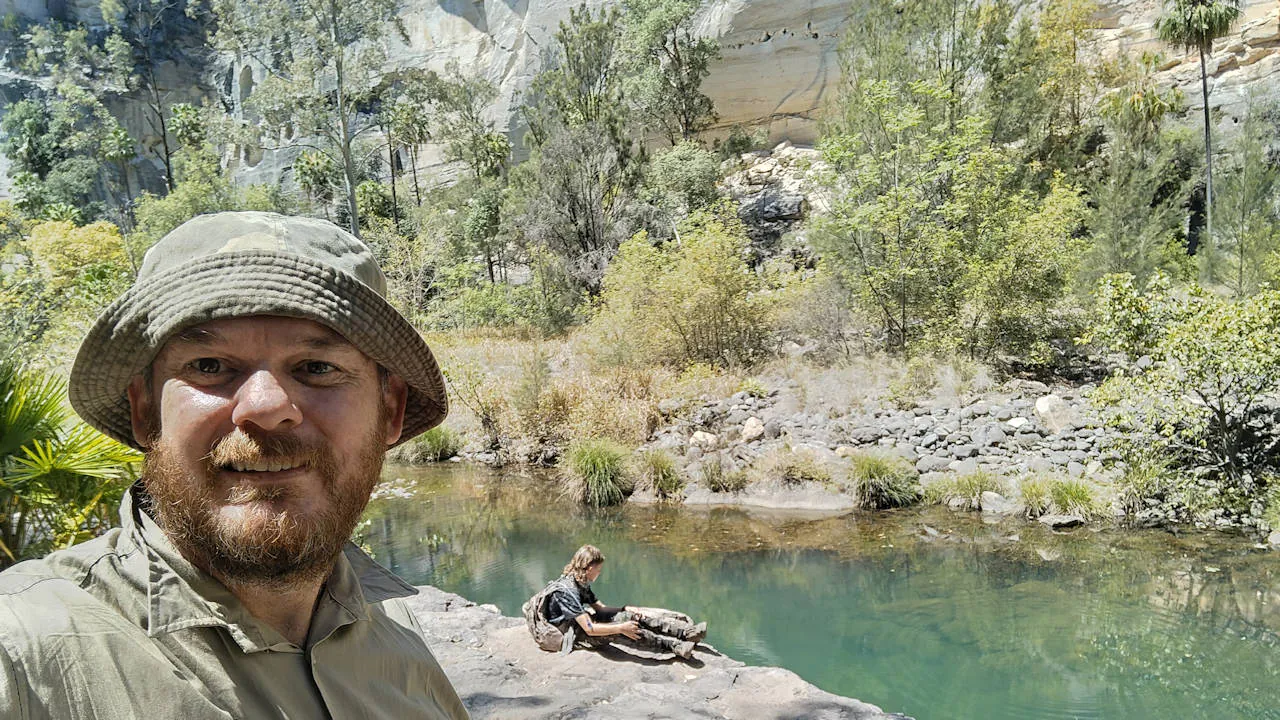
Between Big Bend and the Cathedral, before reaching crossing 13, is another water hole. It doesn’t have a name, at least not a common name in Carnarvon Gorge features, but it was a place we stopped for a break. We could see large fish swimming in the undisturbed water. The white cliffs towering above opposite added to the beauty. You can tell how much closer to the end of the gorge we have walked to, far narrower than when we first set off. If you want to swim at Carnarvon Gorge, the Rock Pool feature (shown later) is where you can go.
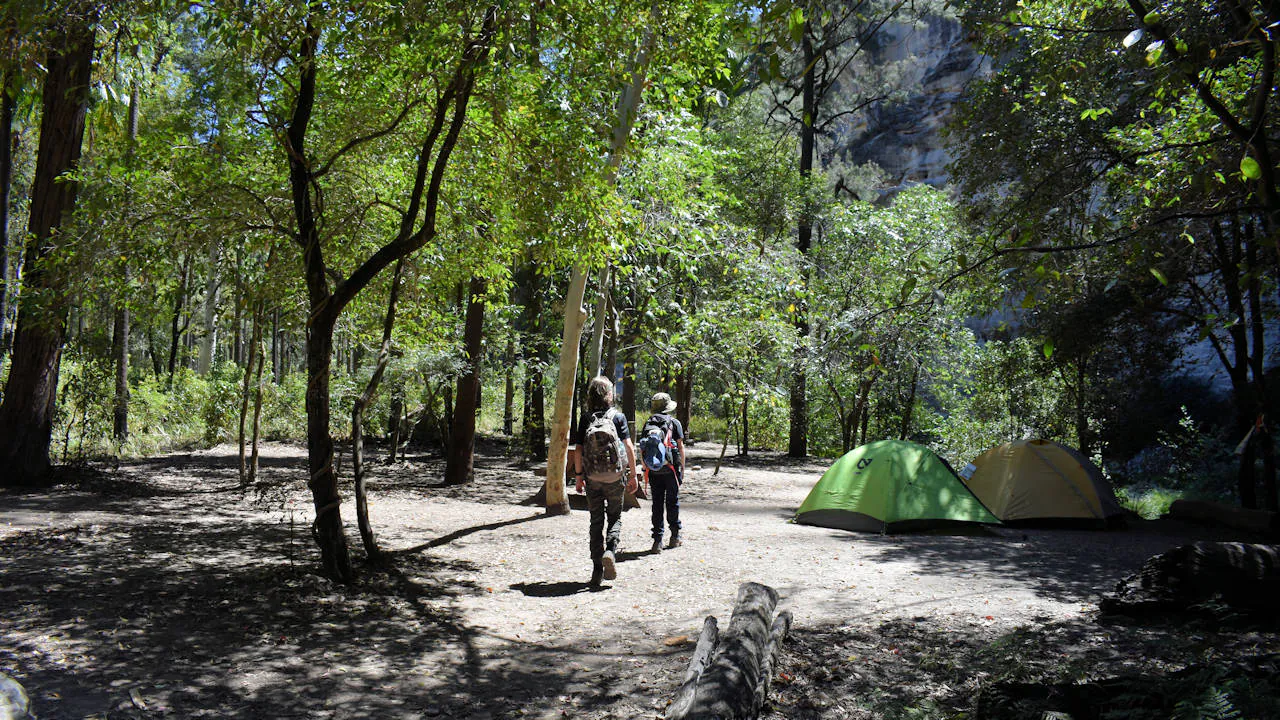
The trail continues a little further after reaching Big Bend, taking you to the camping area and the toilets a little further again. There are a couple of picnic tables, making it a little easier to camp at. While we were not camping at Big Bend, the tables were welcomed for a break before the long walk back – only 10.7km left to go!
Other Walking Trails
These features are not accessed from the main walking trail up Carnarvon Gorge.
Nature Trail
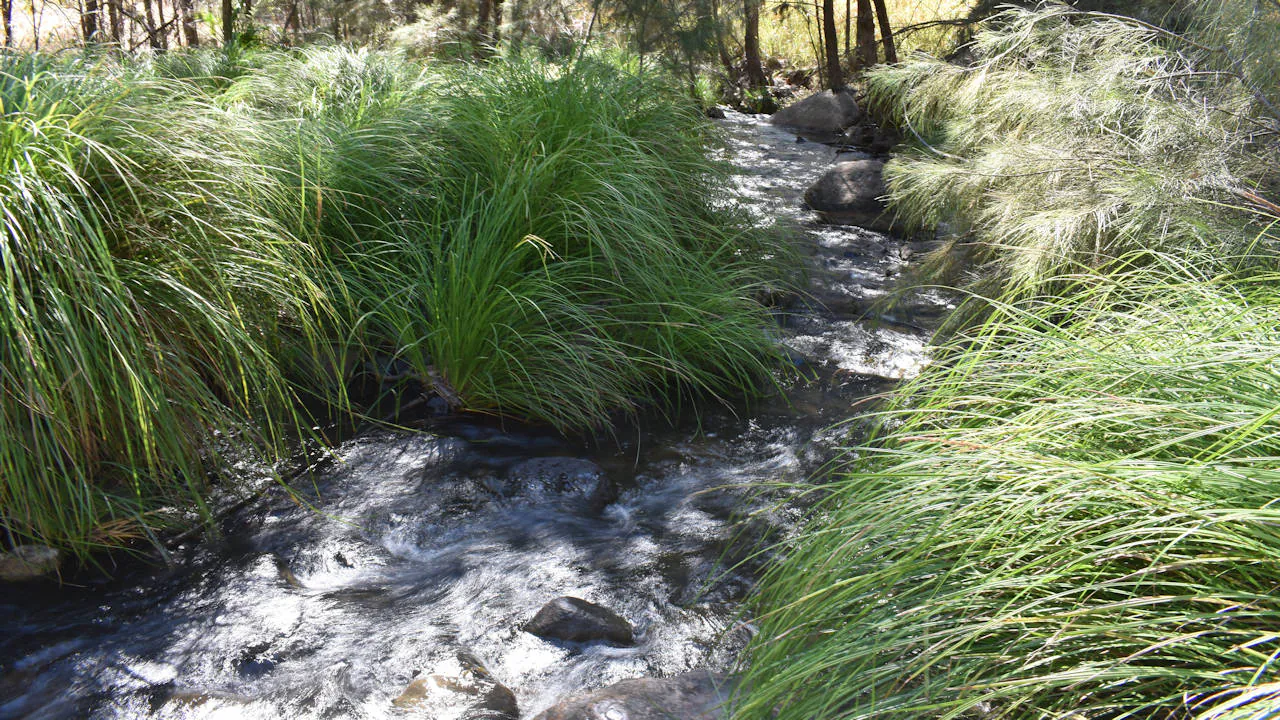
Creek water flowing between green grasses
Walking Distances
Full trail circuit
1.7km
At the start of most of the walks is the Carnarvon Gorge visitor centre and the holiday-season-only camping area. The Nature Trail is a short walk that loops around the creek, crossing at Crossing 1 and another crossing downstream to loop back and complete the circuit. The return is a walk through the camping area and open grass area near the information centre. The other side of the creek is the interesting part of the walk.
While we didn’t spot one, this walk has a high success rate of spotting the elusive platypus. To be fair, we were too late in the day for the best chances. We had already spent a lot of time after spotting a platypus with a young one a while before, on the Rock Pool to Nature Walk.
The Nature Trail is an easy and pleasant walk and the crossings easy compared to many of the main gorge walk crossings.
Rock Pool
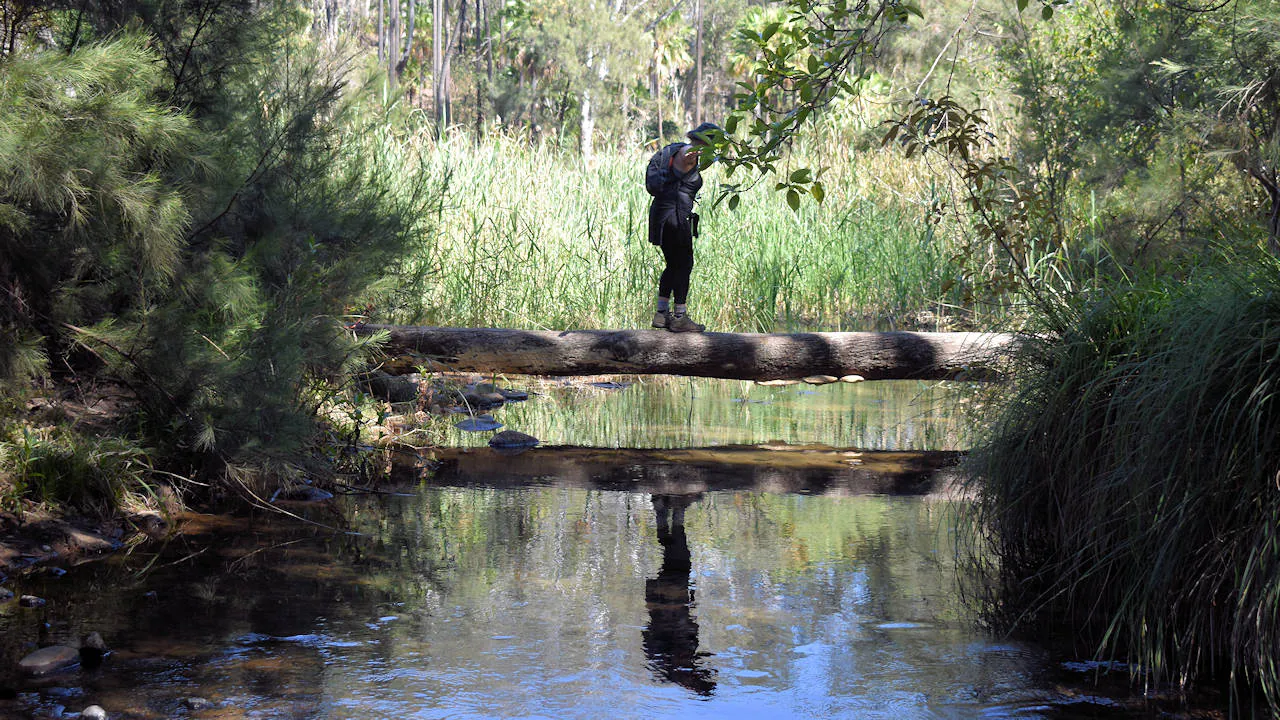
Crossing the creek by log instead of steppingstones
Walking Distances
Full trail return
1.0km
The Rock Pool can be a very popular spot at Carnarvon Gorge. The main drawcard is swimming is allowed so during hot days, the Rock Pool can be busy.
The walk from the parking area isn’t too far. You will come across toilets first, then a few picnic tables at a grassy area. The picnic tables are away from the water so not surprisingly we didn’t see anyone using them. It wasn’t busy when we were there so it may be different when it is busier.
Crossing the creek using some easy stepping stones, a trail heads further downstream to a large waterhole and a large rock. The formed track finishes and the waterhole doesn’t look as appealing as you would expect. However, continue further downstream and you will come to a much nicer part. There may not be an official formed track but there is the familiar stepping stones, this time requiring more balance and coordination. There was a log over the creek with a couple of us opted to venture across it instead of the stones.
Some describe the Rock Pool as being disappointing or even ordinary after walking the main gorge. Like most of the features of Carnarvon Gorge, they have their own appeal in different ways. For us, the Rock Pool is not different, and we enjoyed coming in to see it. If you didn’t realise you can walk further on when the formed track ends, then I understand why you would be disappointed. Having a nicer swimmable spot closer to the picnic table area would help too.
Rock Pool to Nature Trail
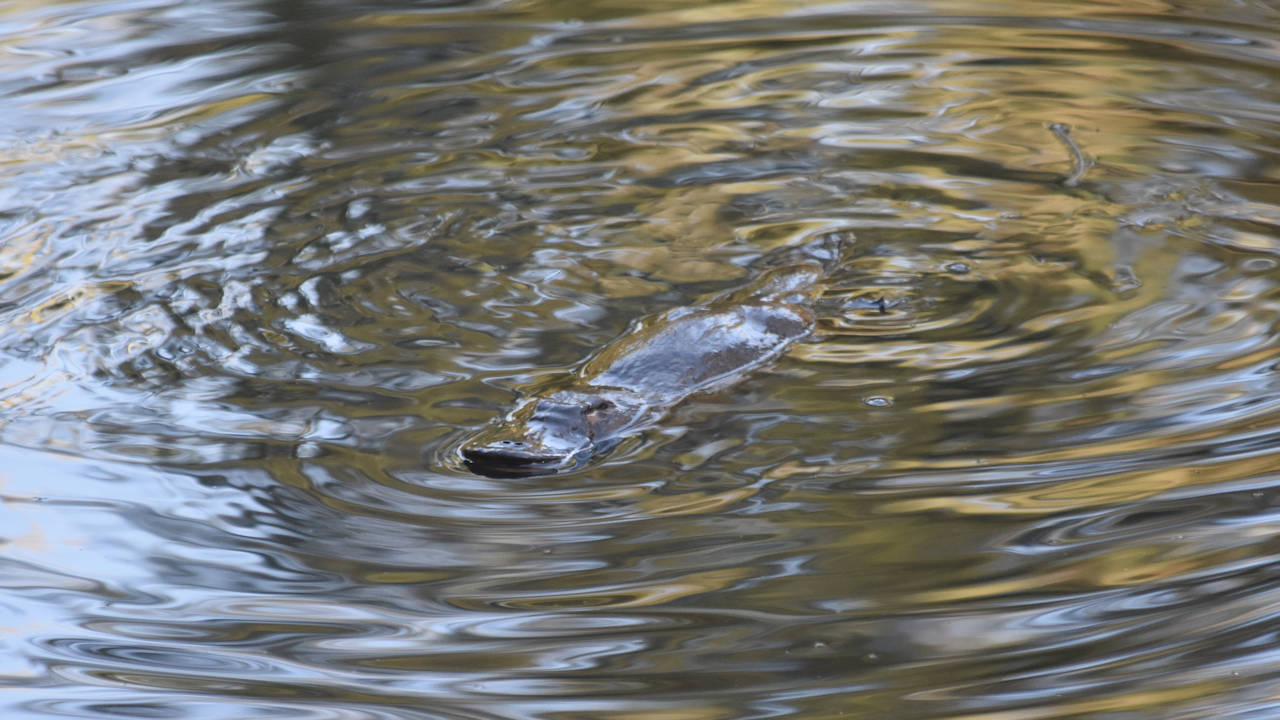
Spotting the shy and timid platypus
Walking Distances
Rock Pools to Nature Trail
2.5km
Return with Natural Trail Circuit
6.4km
Having spent a few days at our camp trying to spot a platypus, we were hopeful to spot one while visiting the Rock Pool or Nature Trail. The trail between the two is where it happened.
The trail is around 2.5km and unless you have been dropped off, you will need to walk back. We started from the Rock Pool entrance and combined the Nature Trail at the other end before coming back to the Rock Pool.
The trail is easy for the most part, with a few spots where the ground is a little uneven. The scenery changes a little, following close to the creek at first, then coming away from the creek along a mostly flat and a little sandy trail through bushland.
There are a couple of creek crossings along the way but are fairly easy. It is near one of the crossings that we spotted some ripples on the water. We had thought we were running too late in our schedule to spot them but the well-shaded creek at this section provided cool cover for the platypus.
Mickey Creek and Warrumbah Gorge
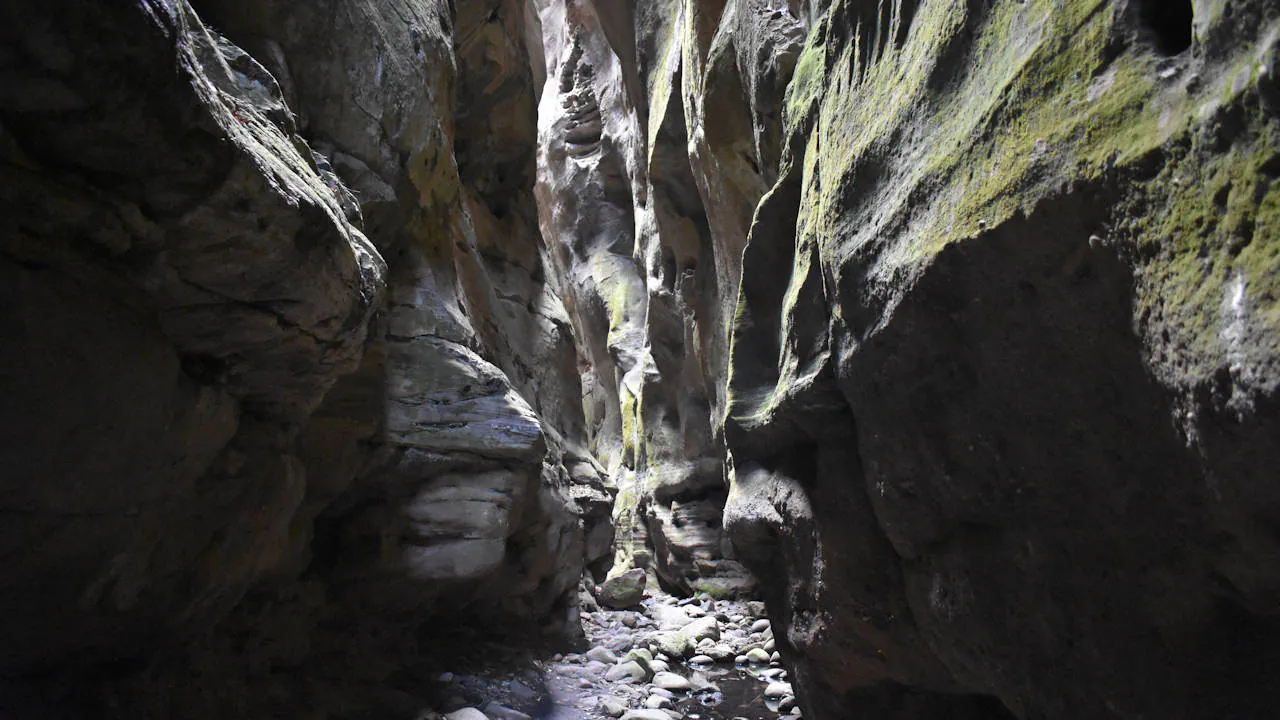
Warrumbah Gorge
Walking Distances
Trail to Junction
1.2km
Mickey Creek Fork return
0.6km
Warrumbah Gorge Fork return
1.2km
Full trail return
4.2km
Mickey Creek and Warrumbah Gorge are two spots on a short walk, separate from the main Carnarvon Gorge walks. Of the two features, Warrumbah Gorge is the one to make the effort for. If you really want to do both, see Mickey Creek first, then see Warrumbah Gorge.
Mickey Creek isn’t bad as such. For me it is similar scenery of what you see on the way to the junction point. Unlike skipping Boowinda Gorge, I wouldn’t regret skipping the last part of Mickey Creek.
As you approach Warrumbah Gorge, the temperature becomes noticeably cooler. We didn’t have anything to measure the temperature but I guess 15+ degrees cooler.
At the start there is a line in the rock similar to Moss Garden where you can see the water seeping out of the hard rock base under the sandstone above it. There is less water coming out, perhaps the hard rock base is tilted more towards Moss Garden.
As you climb further in, the gorge become narrower, and the moisture becomes denser and staler as there is no water flowing. We reached a point where we’d have to walk through some stagnant water but you could have gone a little further (some people did).
The feeling in Warrumbah Gorge was different to many of the Carnarvon Gorge features. There was no life as you progressed into it, bar some moss clinging to the damp rock walls. The coldness of the air added to the atmosphere. After days of amazing rainforest scenery in a fairly arid region of Queensland, it was like being on a different planet.
Walking Plan
Our walking plan was based on 4 full days staying at Carnarvon Gorge. The idea was to get the biggest walk done on the first day. Part of our reasoning is our teenager kids were with us and if they decided a shorter walk was too much it would be difficult to encourage them to take on a longer walk.
Day 1 – Big Bend Long Walk
The first day started as early as we could to take advantage of the cooler morning temperatures. It also lets us be less rushed on the way back, possibly chasing daylight. Big Bend is over 19km return by itself, so we didn’t want to add too many side trails. At the same time, we wanted to do as many side trails at the far end so there would be less double-tracking on the later days.
On the way to Big Bend, we entered Art Gallery, Wards Canyon, Cathedral Cave, and Boowinda Gorge. We left Amphitheatre as an optional side trail on the way back. It adds an additional 1.3 kilometres and by the time we returned we were already too tired.
Day 2 – Moss Garden and Amphitheatre
The third day of hiking, the Moss Garden and Amphitheatre is another walk along the main trail. Moss Garden and Amphitheatre are both an additional 1.3 kilometers from the main trail, one of the reasons to pass them by on day 1. The walk is around 10 kilometres, or 8 kilometres if we managed to head into the Amphitheatre on day 1.
The shorter walk allows for a later start but the cooler temperatures of the morning allows for a more comfortable walk. At under 4 hours, another day with afternoon hours available for relaxing. After all, it is a holiday.
Day 3 – Boolimba Bluff
With advice from friends and research, Boolimba Bluff shows its best at sunrise or sunset. We had to choose between getting up early enough to get to the bluff for sunrise, or time it for an afternoon arrival ready for the sunset.
Originally, we planned the early sunrise walk for day 2, however, after the long walk on day 1, we decided to have a sleep in until 6.30am. Today, we woke at 3.30am and started the walk at 4.15am.
No other walks planned for this day, however, adding the Rock Pools in the afternoon was discussed. Also, we figured the afternoon would give us a chance to catch up on washing clothes. In the end, we had troubles getting our washing done and there was a swimming hole at our camp instead of heading out again.
The day was quite hot too, so we welcomed the slower paced finish for the day.
Day 4 – Mickey Creek and Warrumbah Bluff and Rock Pool
Our last full day at Carnarvon Gorge is the most relaxed with a couple of shorter walks. Mickey Creek and Warrumbah Bluff are done first, again in the morning but not before a more relaxed cooked breakfast. Then later we head to the Nature Trail and Rock Pool. We are packing up the following morning so a more relaxed day is welcomed.



